Changelog
Nov 15, 2023
AI admin panels, fullscreen record pages, improved action editor
1. AI-generated admin panels
Our vision at Basedash has always been to handle all of the hard work of creating the best admin panel so that you can focus on building your own product. Until now, we’ve mostly been focused on solving that through good design and smart defaults.
Today, we’re shipping an improved onboarding experience that automatically generates your entire initial admin panel using generative AI. As soon as you connect your database, we use AI to scan and understand the schema of your database, then generate a set of views that we think would be useful for you and your team.
All newly created views also now automatically understand the relationships between the tables in your database. We use this to join related data into your views so that you can see how your data is connected without any manual configuration.
Expanding on our new dashboards feature, we’ll also pin any newly created views to your team dashboard automatically.
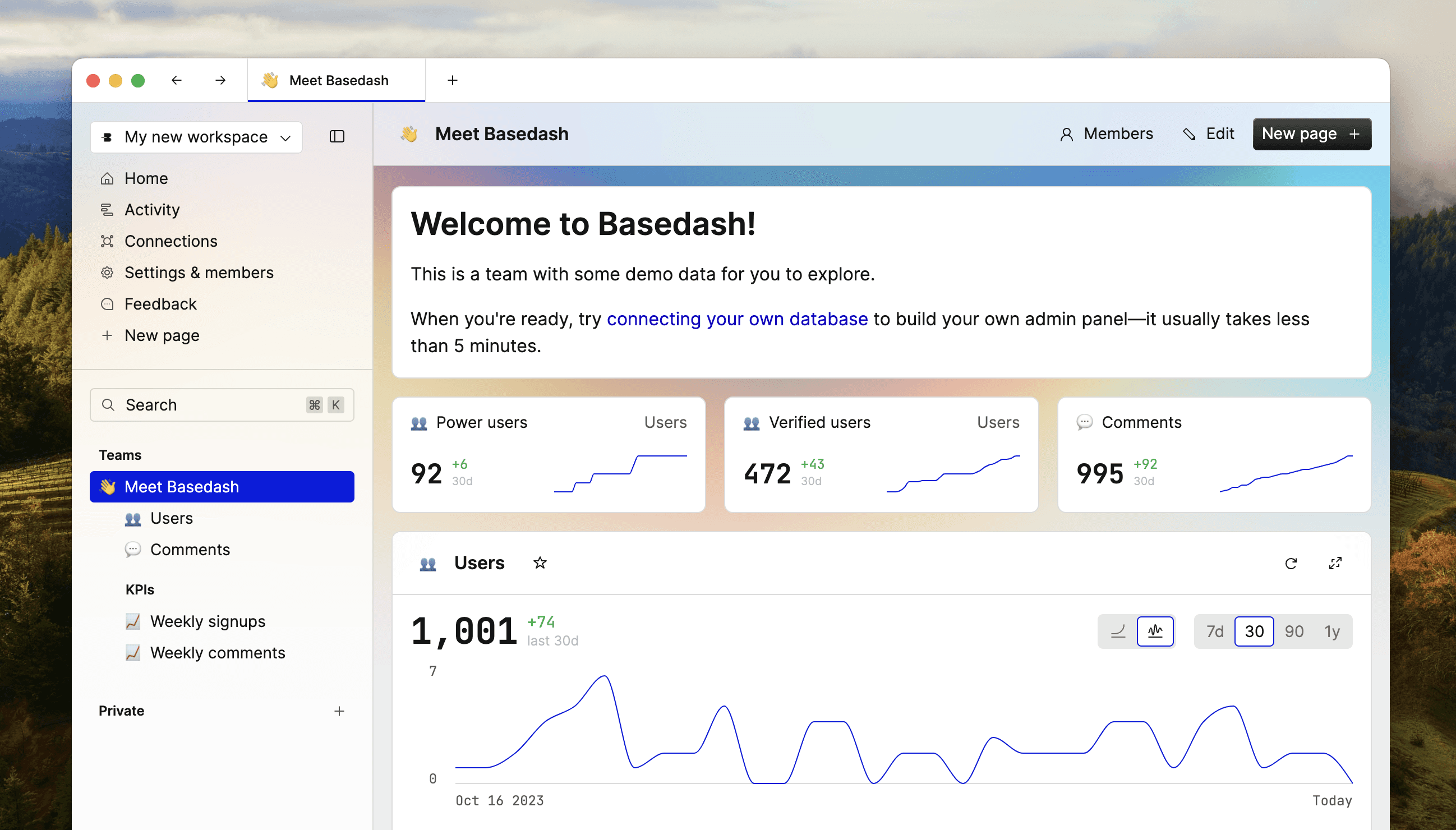
2. Fullscreen record pages
We’ve added a new fullscreen page for individual records that lets you dive into all the details and view relations in a space dedicated to your data. You can open a record’s page by clicking the expand button on the side panel of a view, or holding Ctrl/Cmd and clicking on a record in list or card layout.
We also now link to these record pages from the activity feed so you can see exactly how records have been changed over time.
You can also use this new feature to link to specific records from other sources, like your CRM or issue tracking software. We use a simple URL that you can construct using the record’s unique ID.
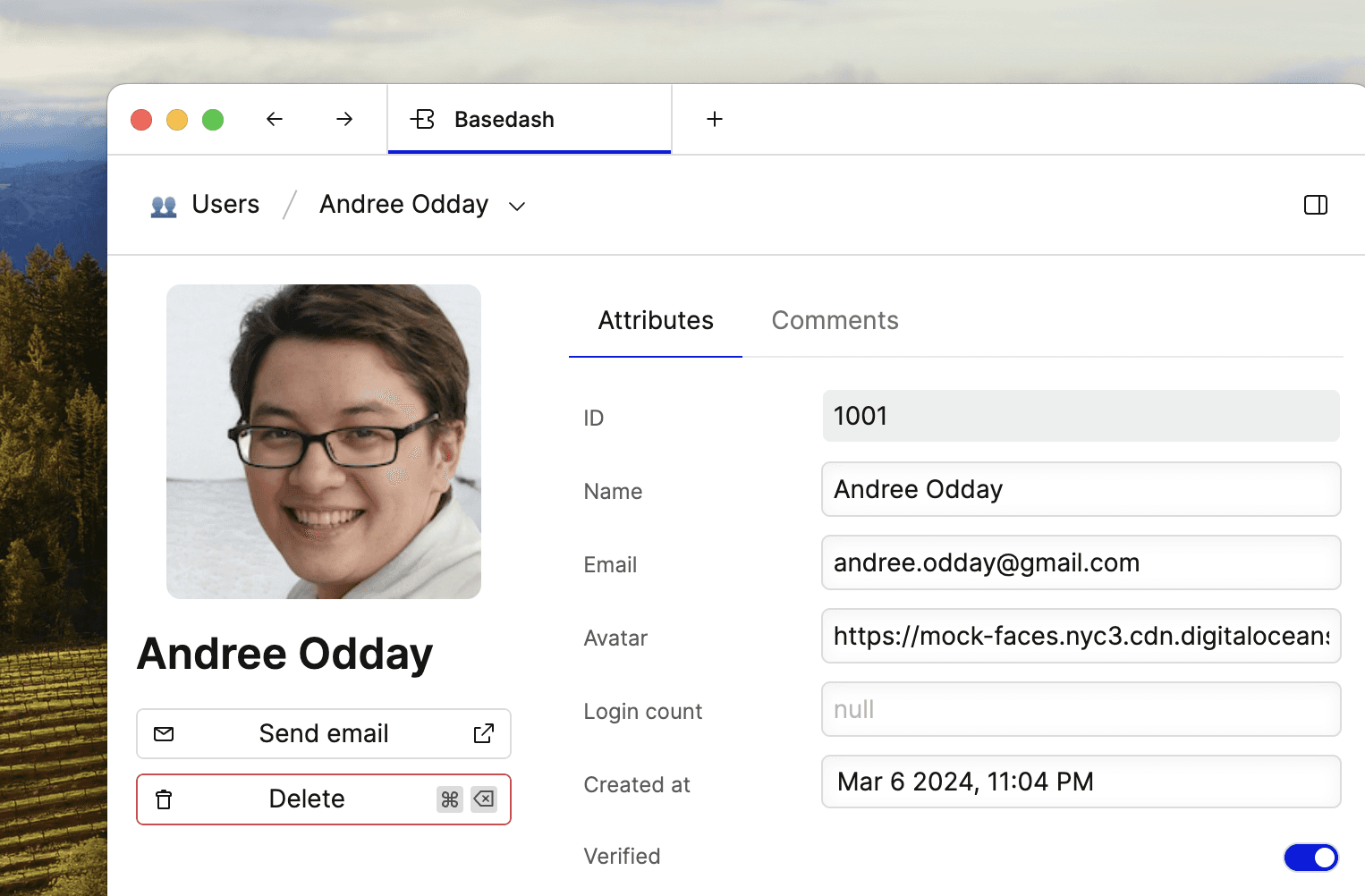
3. Redesigned action editor
We’ve totally redesigned the action editor to be simpler to use, and more consistent with our view and query editing process. The action editor now appears in a sidebar, keeping the primary interface focused on your action. We’ll also auto-save any changes you make so that you don’t lose any progress while building complex actions.
We’re also working on a new feature in beta that lets you define custom actions with natural language by using AI. If you want early access, let us know and we’ll add you to the feature flag.
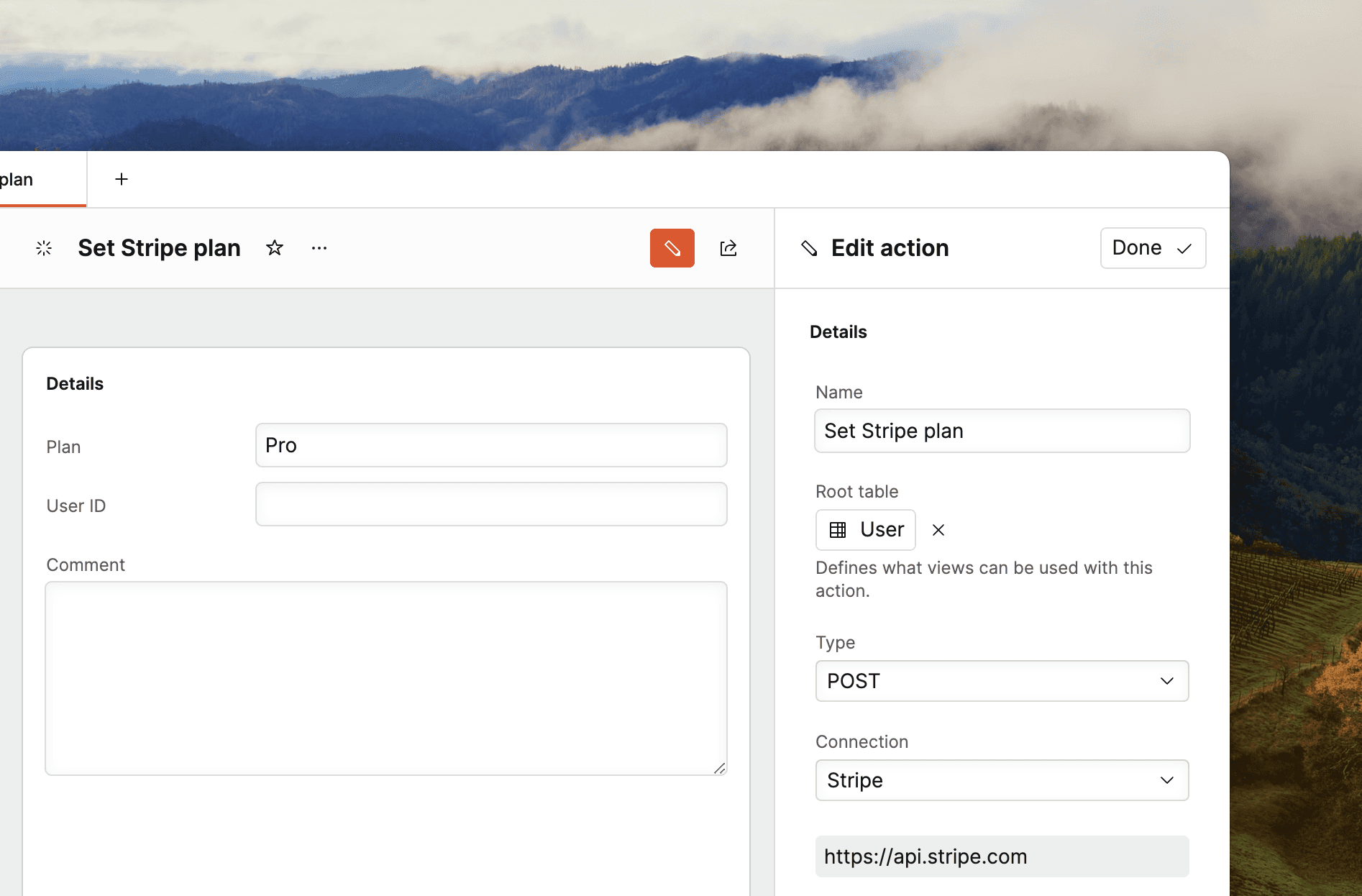
4. Bug fixes and improvements
Fixed team cover image positioning
Improved performance of creating views with relations
Improved SQL assistant’s usage of enums
Fixed keyboard shortcuts not responding after using the command palette
Expanded SQL assistant support to databases with larger schemas
Updated layout of view editor
Added SQL formatting to new AI-generated queries
Added ability to hide automatic email and Stripe links
Added page icons to command palette
Added options to edit, duplicate, and delete pages from the command palette
Fixed editing foreign keys in modals
Improved attribute selector in view editor
Expanded CSV exports to support larger tables
Added new demo team for new users
Fixed removing non-admin workspace members
Added delete option on pages in the sidebar
Added support for record creation on views with joins
Added option to exclude action input values from activity
Added a default sort to new views
Fixed support for new SQL Server databases
Added cumulative charts in addition to discrete charts on views
Fixed cURL preview when creating actions
Updated icons for toggling panels
Added support for action inputs with the same name
Added support for saving actions with errors
Added view name and emoji to pinned segments on team dashboards
Updated theme picker graphics
Added ability to delete workspaces
Changed behavior of time columns to not display in local time zone
Fixed editing time columns
Fixed time zone agnostic columns being converted to local time zone
Added time zone indicator to time zone aware timestamps
Added zero-downtime deployments
Updated position of indicator for updating the app
Improved performance of connecting new databases
Added empty state to domain settings
Sep 28, 2023
Launch week day 4: Dashboards, segments, time-series
Welcome to the final day of Basedash launch week.
We saved the best for last: 📈 Dashboards 📊
The name “Basedash” comes from combining two words: Database and Dashboard.
Until now, we’ve focused entirely on accessing and editing data. Today, we’re announcing features that help you build dashboards with that data.
This is all very much a v1, and we’ll be adding more functionality to these features over the coming weeks. We’re excited for you to try them out and let us know what you think.
1. Dashboards
With Dashboards, every team in your workspace gets its own customizable page to show things like daily signups, weekly active users, or anything else you might store in your database.
To set up a Dashboard, simply navigate to a Team and click the edit button. When you edit a Team, you’ll notice a new section in the editor called “dashboard cards.” This allows you to select some or all of your existing Views or Queries to pin to the top of your Team page.
By default, each dashboard will appear as a compact card with a metric and corresponding chart. You can edit each card in the side panel to appear as a full view, which will expand the card to display more information.
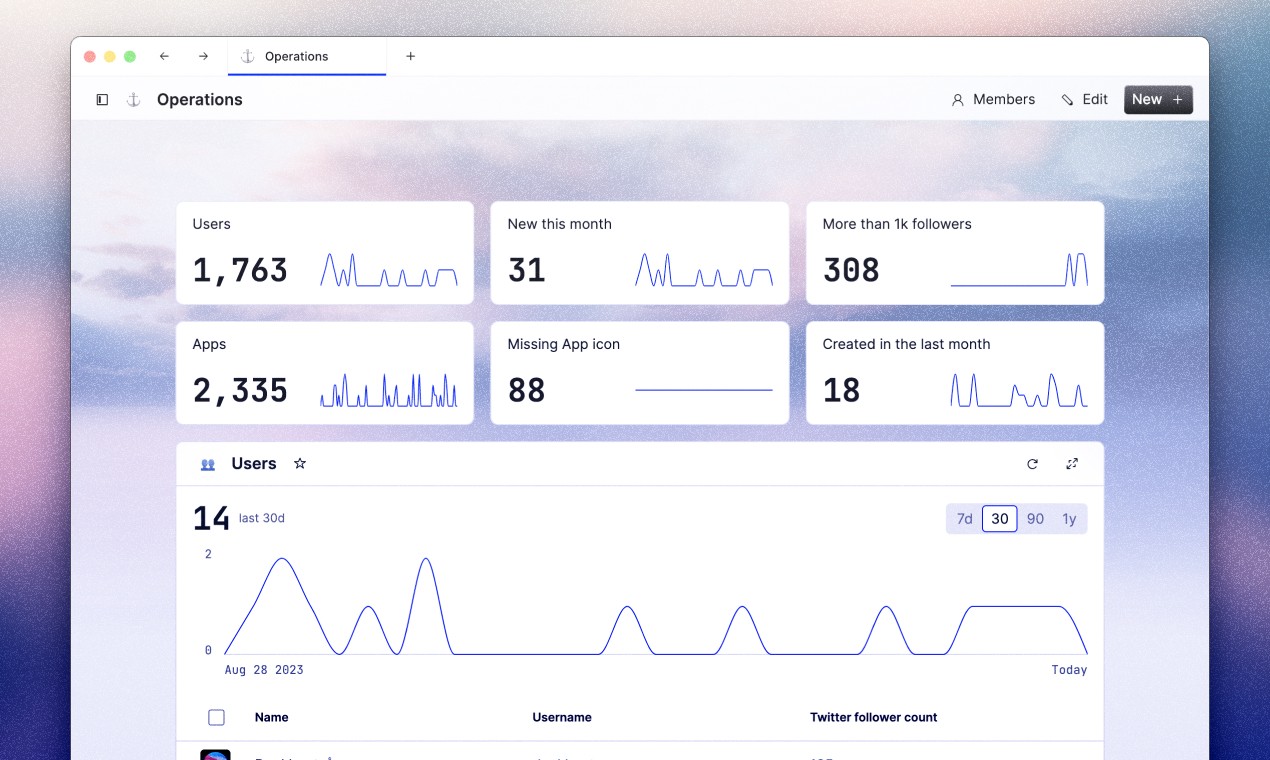
2. Segments
We’ve shipped Segments out of beta. Segments allow you to filter your data and save that as a card in the side panel for a given View. This allows you to jump between different sets of filter in just 1 click.
Previously you would have to consistently duplicate Views or reconfigure filters to that page. Our goal with Segments is to give you and your team access to the granular data you need without having to go through the extra steps of applying new filters or navigating back and forth between otherwise identical pages.
On Dashboards, you can also choose to pin a Segment rather than the full View.
You can also pin segments to your Dashboards.
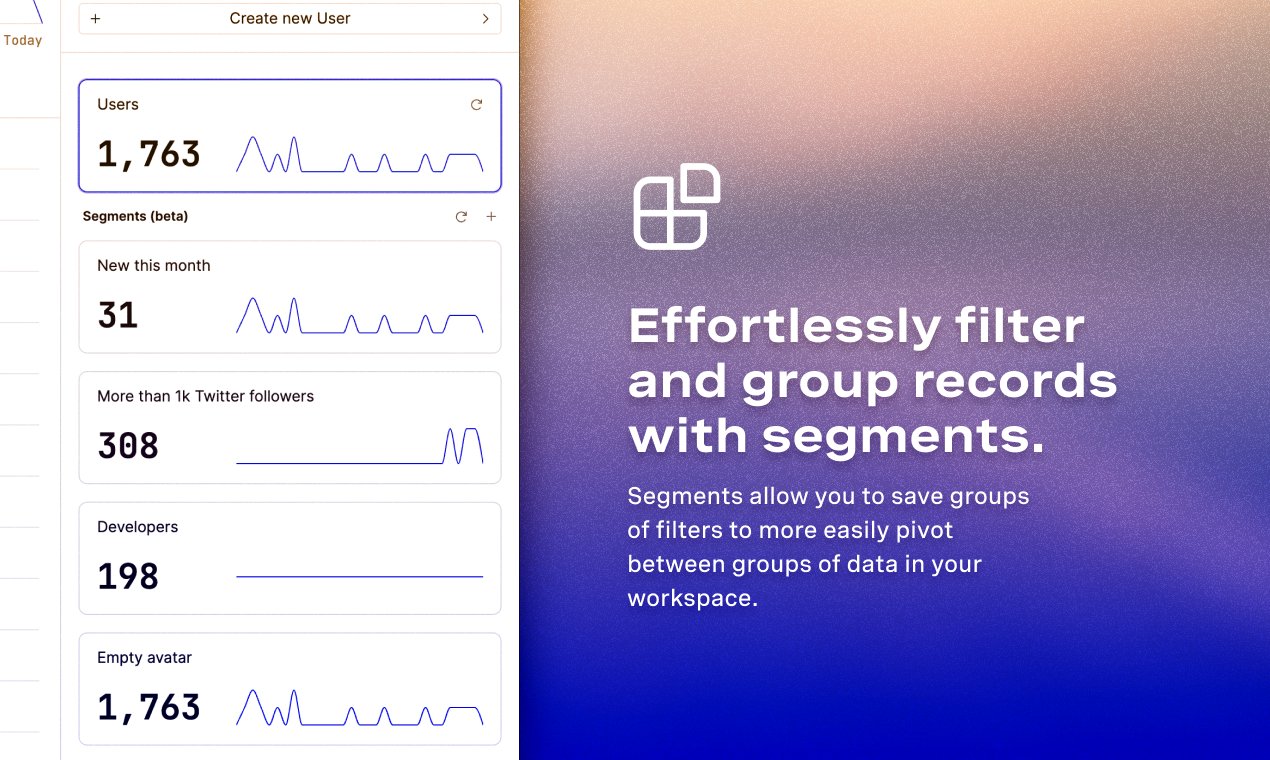
3. Automatic time-series
When you create a View, Basedash will now automatically a time series chart based on your table. This chart will display record creations over time.
For instance, if you create a View of your product’s users, you’ll see a chart at the top of the page that shows a time series of the number of new users over time. This is great if you want to track things like new user signups and quickly understand how they are trending over time.
This requires no configuration. We’ll automatically create these time series charts on any table that has a date column.
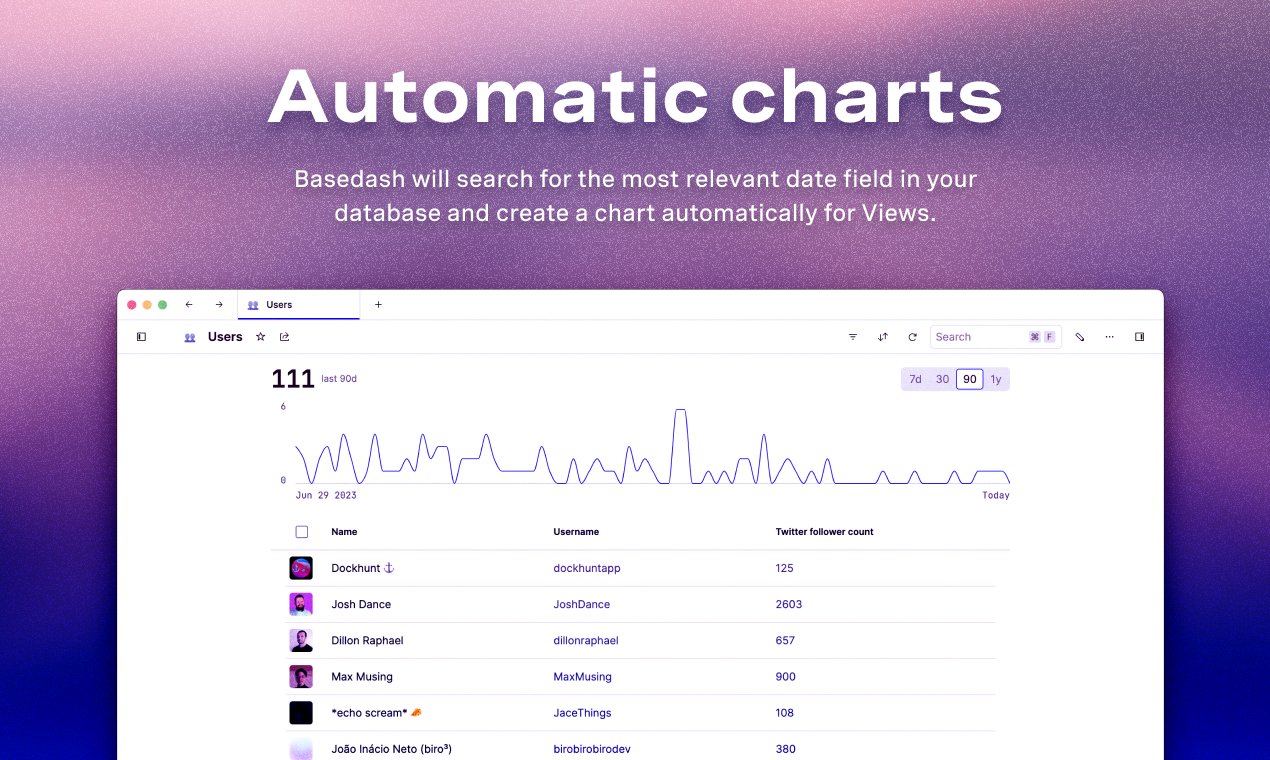
Sep 27, 2023
Launch week day 3: Record enrichment, Stripe, automatic relations
Welcome to day 3 of Basedash launch week ✨
On Monday we launched an AI SQL assistant, and yesterday we announced our new view builder.
Both are great ways to work with data stored in your database. But what about data that isn’t stored in your database?
Today, we’re releasing a set of features to enrich your Views with data from external sources.
1. Enrichment
Now when you create a View, Basedash will search your database for records that contain emails and auto-enrich it with the social data associated with that email address. Think: information like that individual’s job title, links to their social profiles and their company URL.
This is super helpful for tech companies who want to understand what kinds of users are signing up for their product—or any use case that involves storing customer data.
This feature is still in closed beta—reach out if you’d like early access before we release it to all paid workspaces.
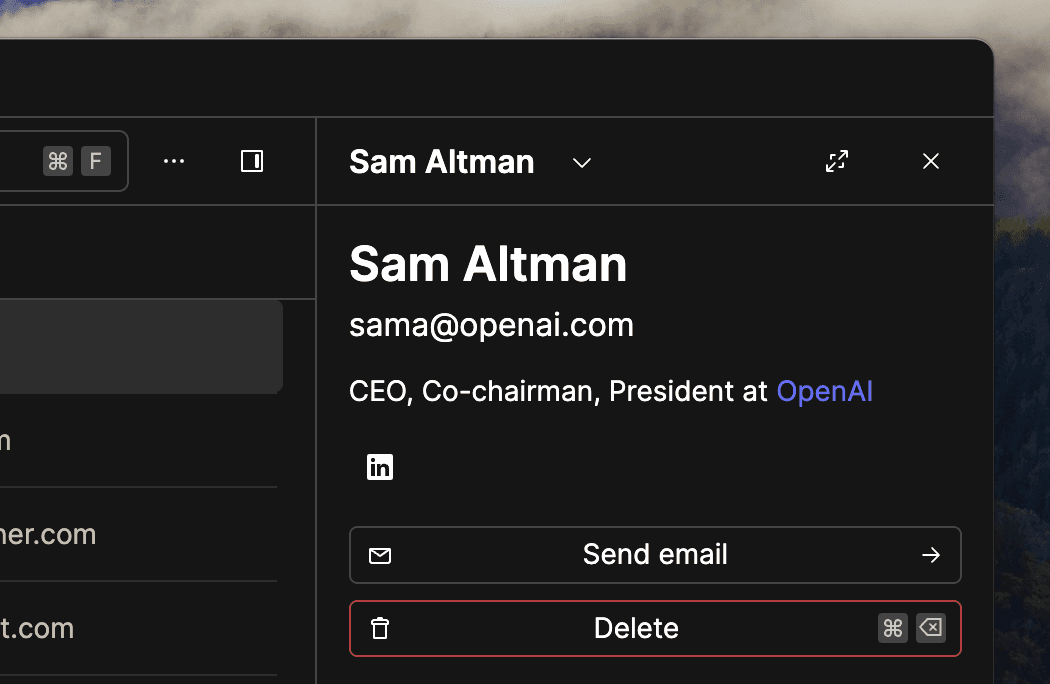
2. Stripe data
We’ve made it much easier to bring Stripe data into your Views.
Now when you set up a View, we’ll automatically scan your database for a related Stripe ID. This means that we’ll add a convenient link to the Stripe Dashboard page associated with that record.
Note that we do this whenever we see a Stripe ID, whether it’s for a customer, a subscription, or an order.
Many of our users rely on Basedash for their core operational workflows. We made this feature so that you can more easily keep track of customer data—and navigate directly to Stripe from the work you’re doing in Basedash.
We’ll be improving this feature over the coming weeks, including actually embedding data from Stripe directly in the Basedash UI
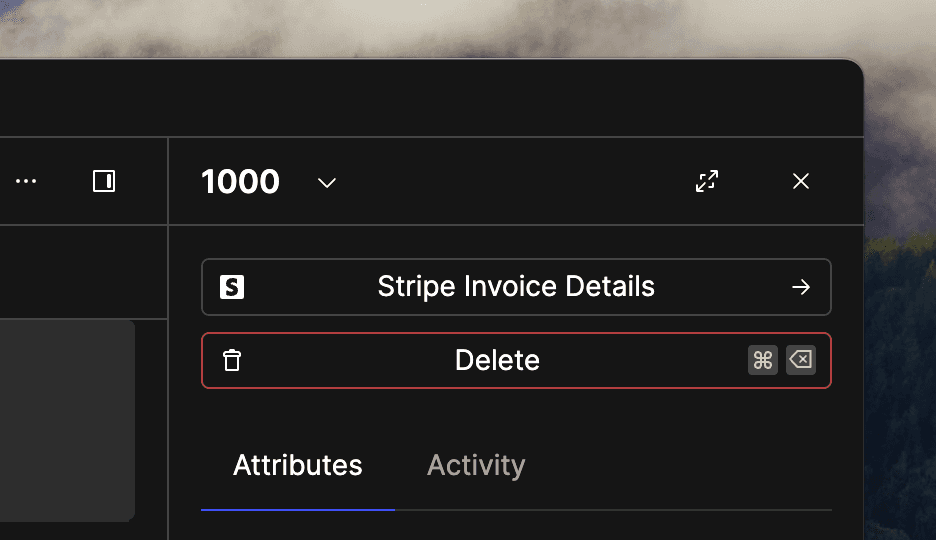
3. Automatic relations
Relations, which allow you to display related records in the side panel of a View, have been a key feature of Basedash for some time.
We’ve made it even easier to set them up.
Now when you create or edit a View, we’ll automatically look for tables that share the same foreign key column and include them as Relations.
This basically means you’ll be able to access all records that related to your View without having to necessarily navigate to a different View.
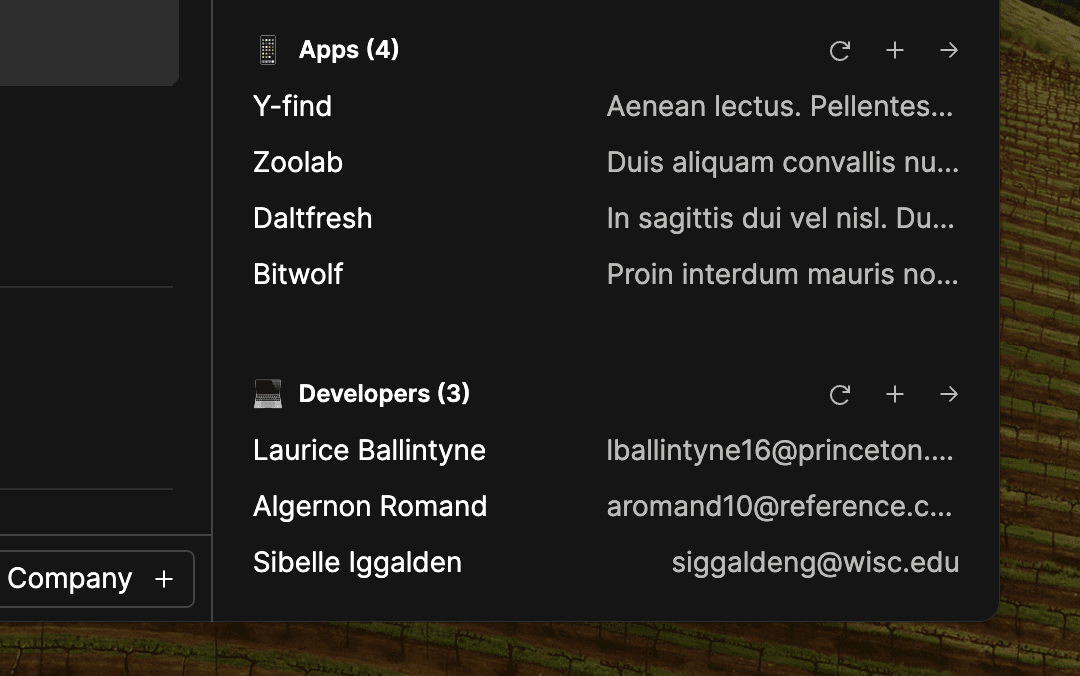
Sep 26, 2023
Launch week day 2: View builder, long text editing, image URL interpolation
Welcome to day 2 of Basedash launch week ✨
Yesterday we launched our AI SQL assistant to help you build powerful queries.
Today, we’re shipping a number of improvements to our view builder, so that you can build powerful, customized admin panels with little to no work.
1. Redesigned view builder
Views are a core part of Basedash. We use advanced AI under the hood to automatically configure them for you - from picking a display image to setting up Actions to choosing which columns to display in a list.
There are, of course, some instances where you may want to manually build or edit a View. We’ve totally redesigned the view editor to make this even easier to do.
The new view builder makes it faster to go in and out of edit mode. We’ve also simplified the editing flow so that it’s easier to configure your view. And you can now see live previews and proposed changes in-context while in edit mode.
We’ll be adding more improvements to this flow in the coming weeks, including direct manipulation and better layout controls.
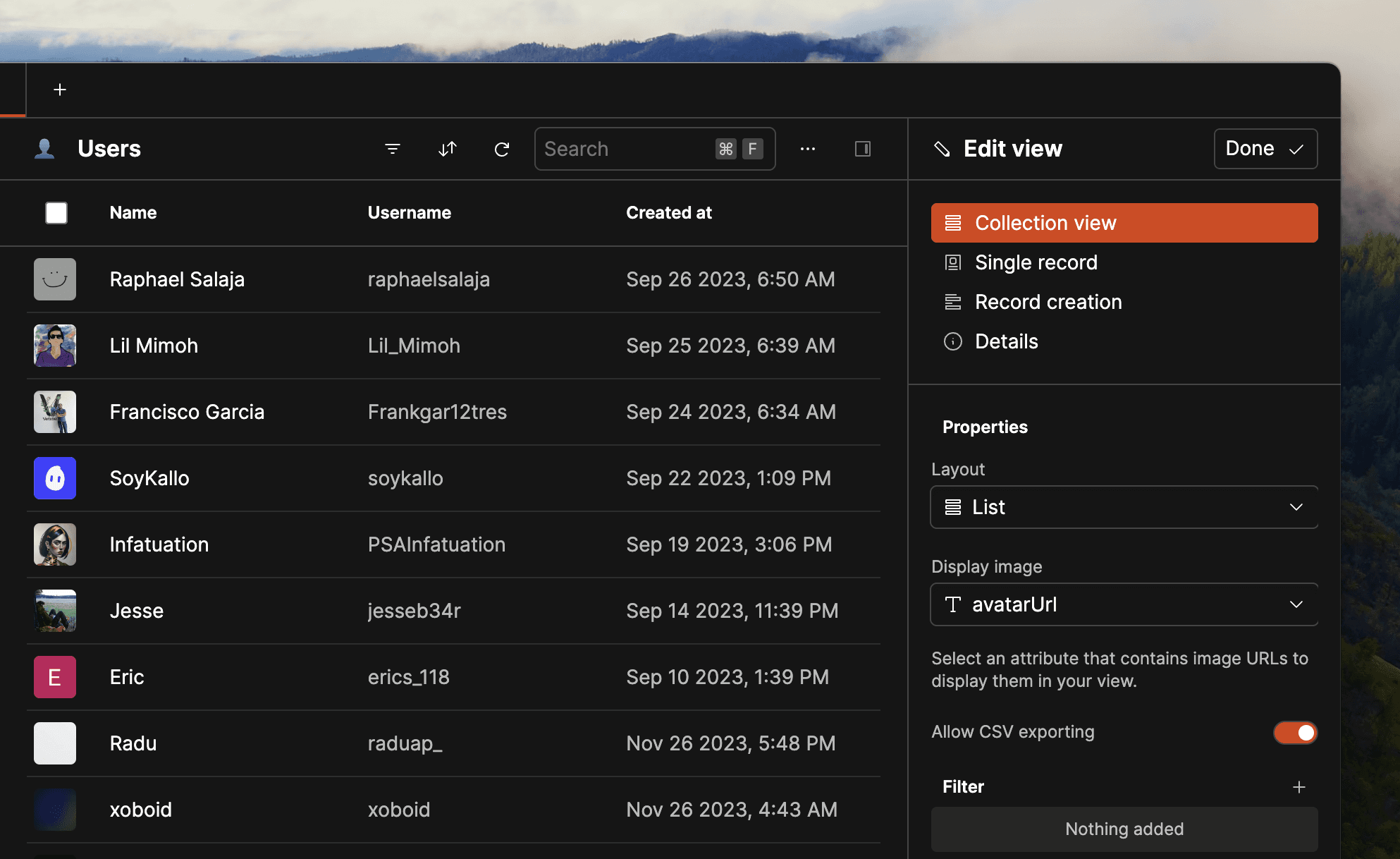
2. Long text editing
We’ve made it easier to work with longer-form content.
If you have longer strings in certain text fields (like comments, product descriptions or notes) or if you heavily use data types like JSON or HTML, it’s now much easier to preview and edit that content.
Just expand the field and you’ll get a full page experience.
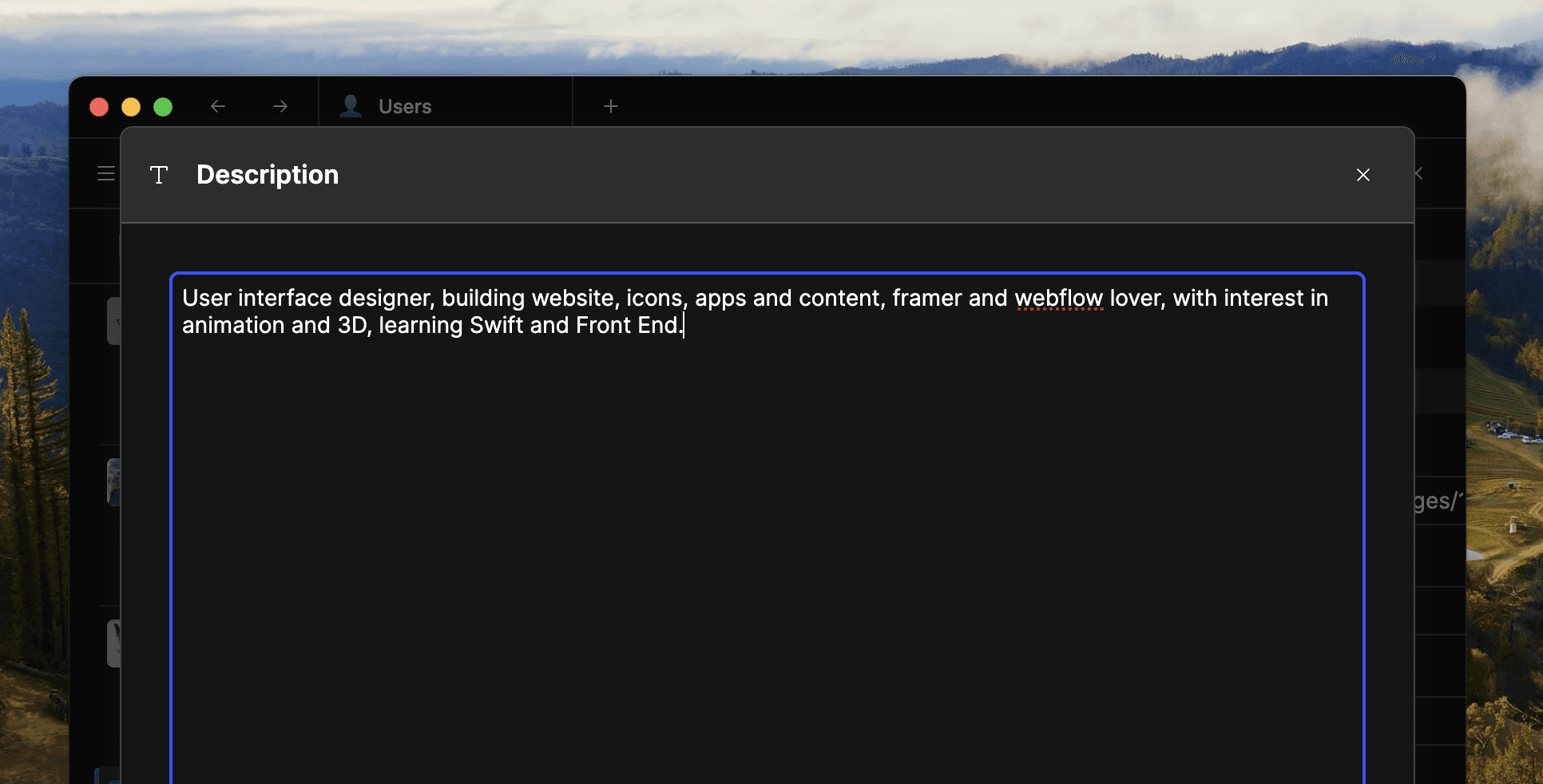
You can also now make a single record full-screen so that you can focus on a single record at once and not be distracted by all of your View contents.
We’ve also made it easier to jump between individual records in this layout. You can click on the name of a record and search for a specific one, or jump between between adjacent records by clicking the up or down arrows.
We’ll be adding improvements to this record view over the next few weeks, so stay tuned.
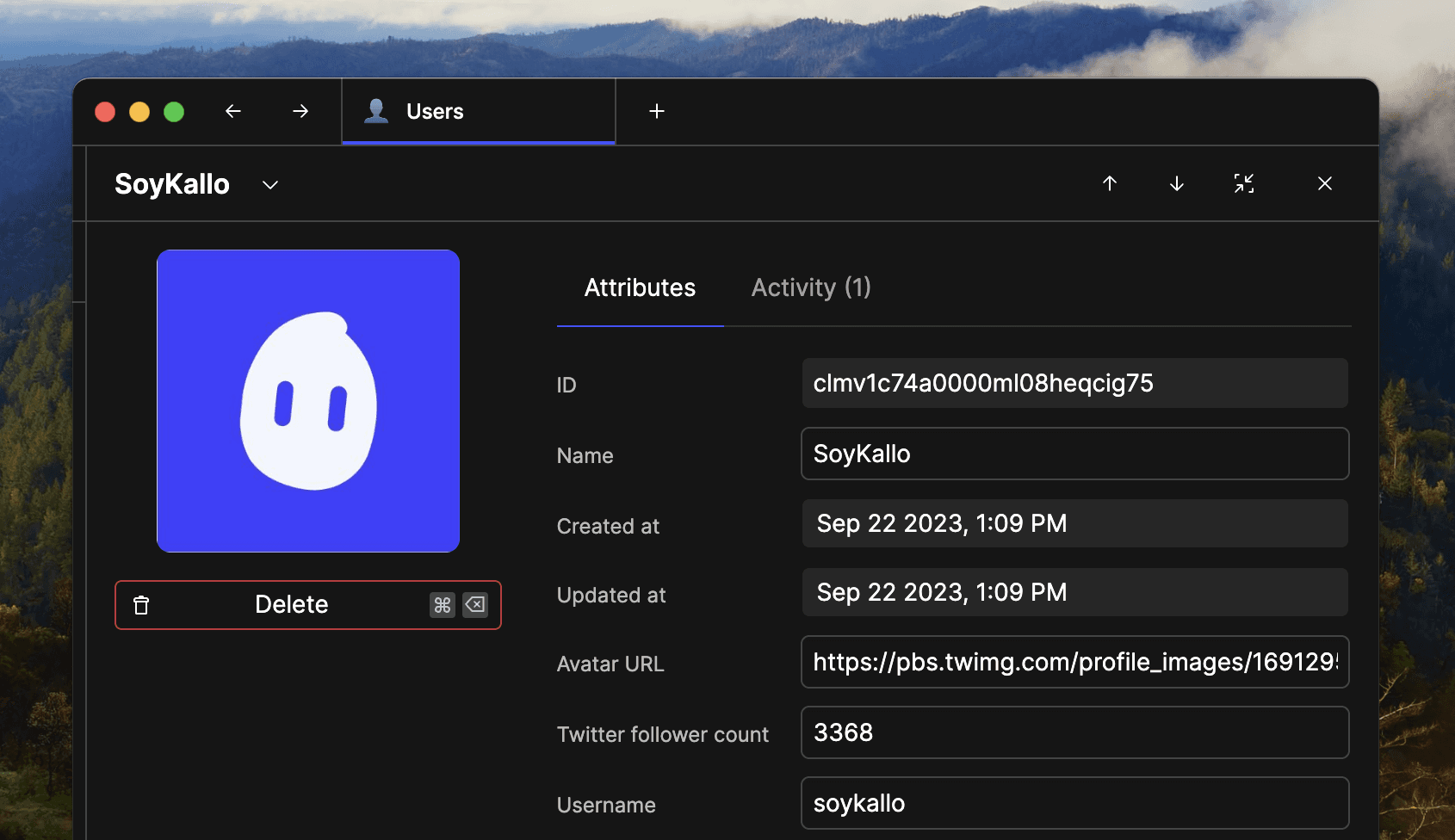
3. Image URL interpolation
We’ve made it easier to identify images in your database. You can now prefix or suffix a URL with your column values to allow Basedash to display images where URL parameters aren’t included.
For example, if you just have the name of your asset you can now include the base URL for your file storage service. You can also slice and dice any combination of values from your database to compose a single URL string.
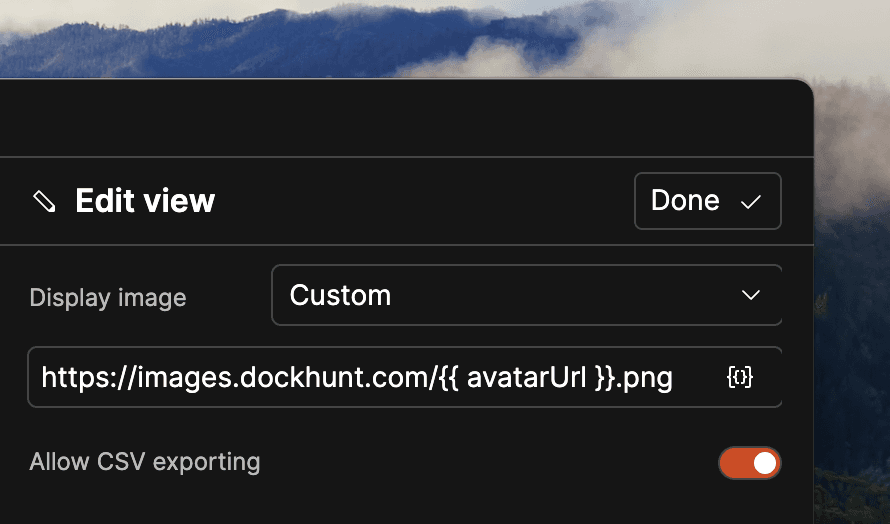
Sep 25, 2023
Launch week day 1: AI SQL assistant, permissioning, SAML SSO
Today we’re kicking off our first launch week.
At Basedash, we’re building the best way to view and manage your data. We’ve come a long way towards delivering on that promise - and we have several major improvements and features to show for it.
We’ll be releasing them each day between today and Thursday, so keep an eye out for announcements.
1. AI query assistant
You can now use an AI-powered SQL assistant to help you write queries. You can find the AI assistant right above the SQL editor when you create a new Query. The assistant understands the structure of whatever database you have connected to Basedash, so simply describe in plain English the data you want to see and the assistant will automatically generate a query for you.
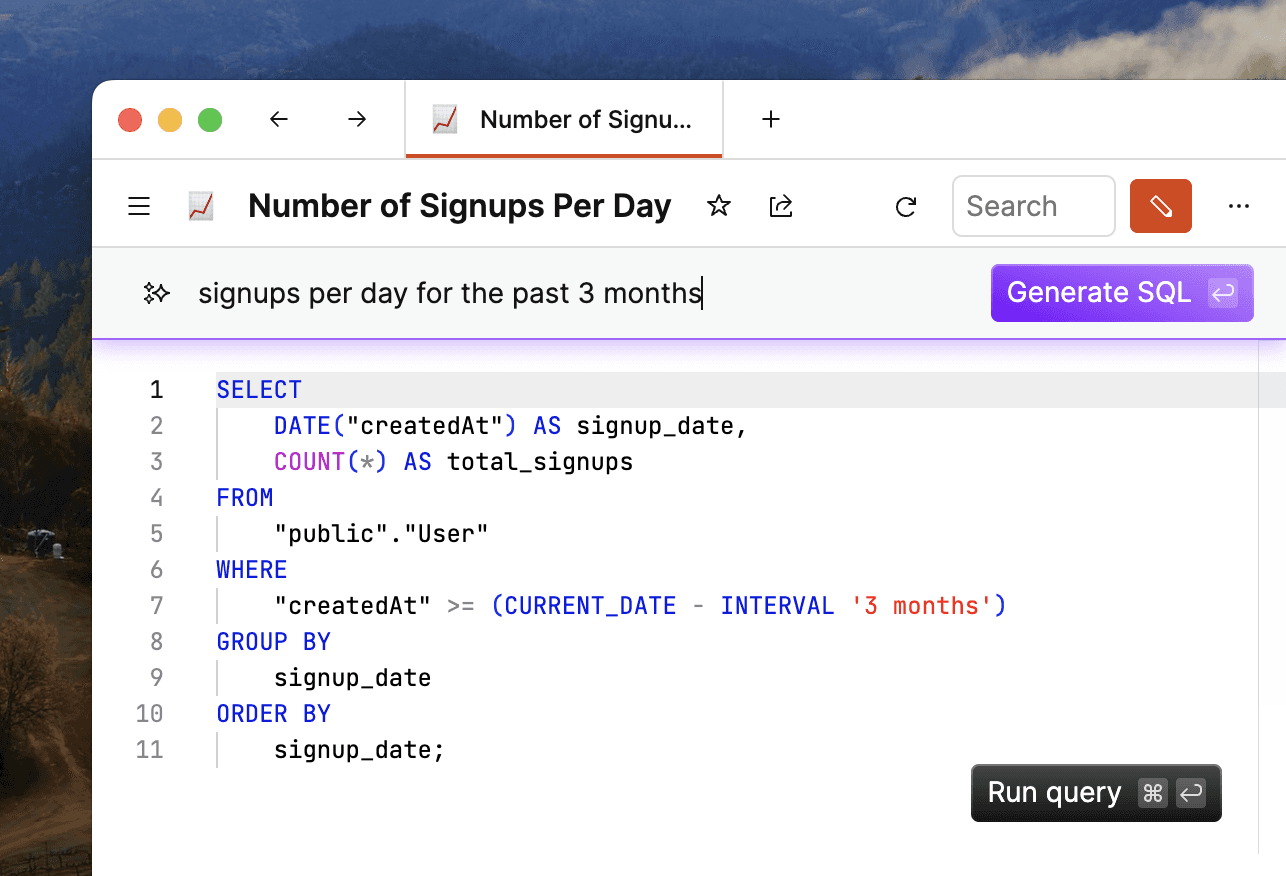
The assistant can also read through broken queries to help you identify what went wrong (like broken syntax or an incorrect column name). Simply click the “ask AI to fix” button next to the error message.
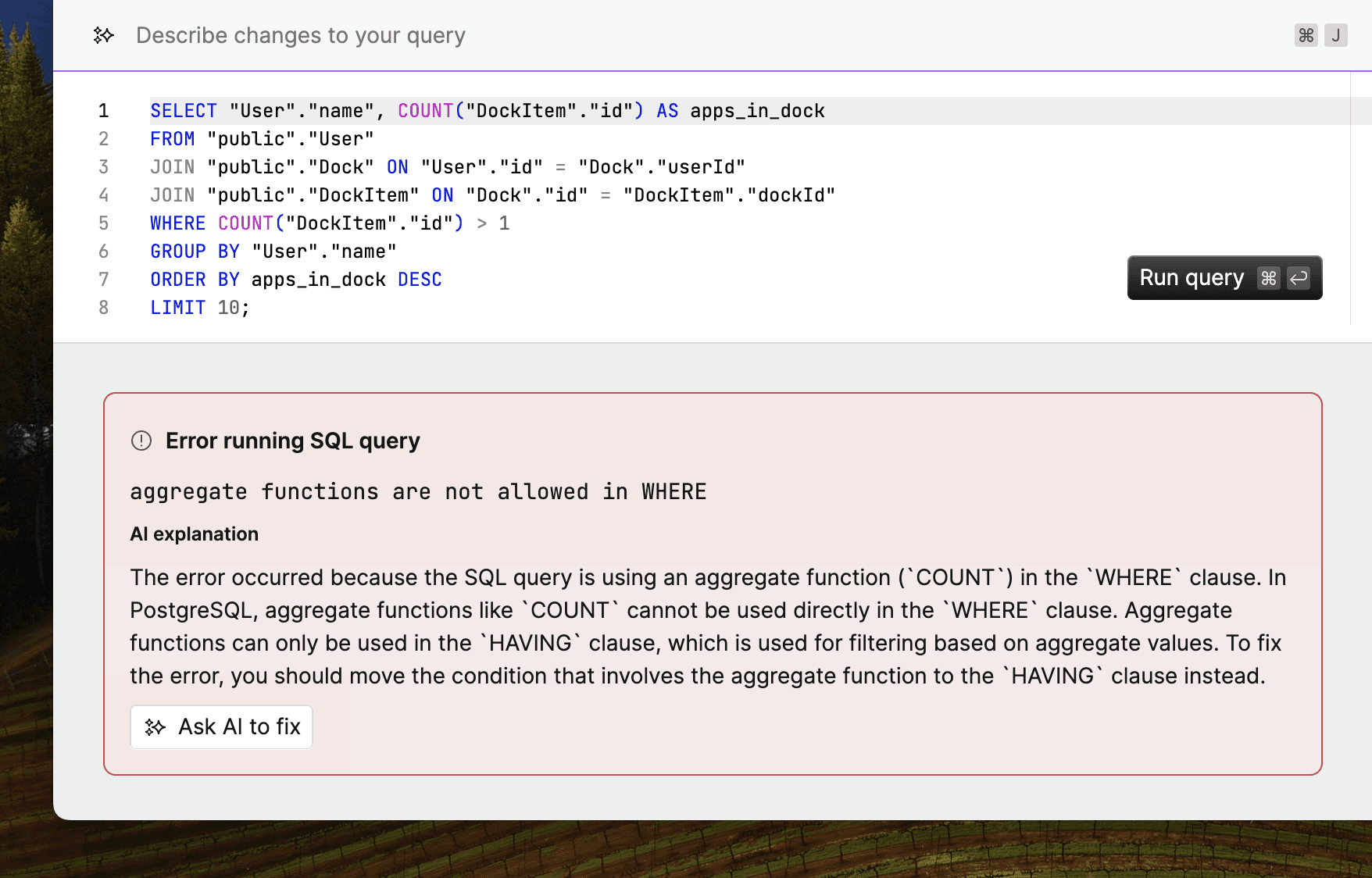
2. Permissioning
We want teams feel comfortable letting their colleagues write SQL queries. We’ve added two improvements to our permission system to ensure that members of your workspace have exactly as much access as you allow.
First, you can only run SELECT statements in queries - which means you can no longer run queries that delete records or drop tables. (Note that if you want team-members to edit and delete specific records, you can enable that workflow under a View).
Second, we’ve added Creators - a new role for your workspace settings. Creators can create new views and queries, but not manage anything at the workspace-level. That means you can now enable teammates to write create and edit SQL queries without giving them Admin access to the entire workspace - perfect for colleagues who want to try the new AI SQL assistant.
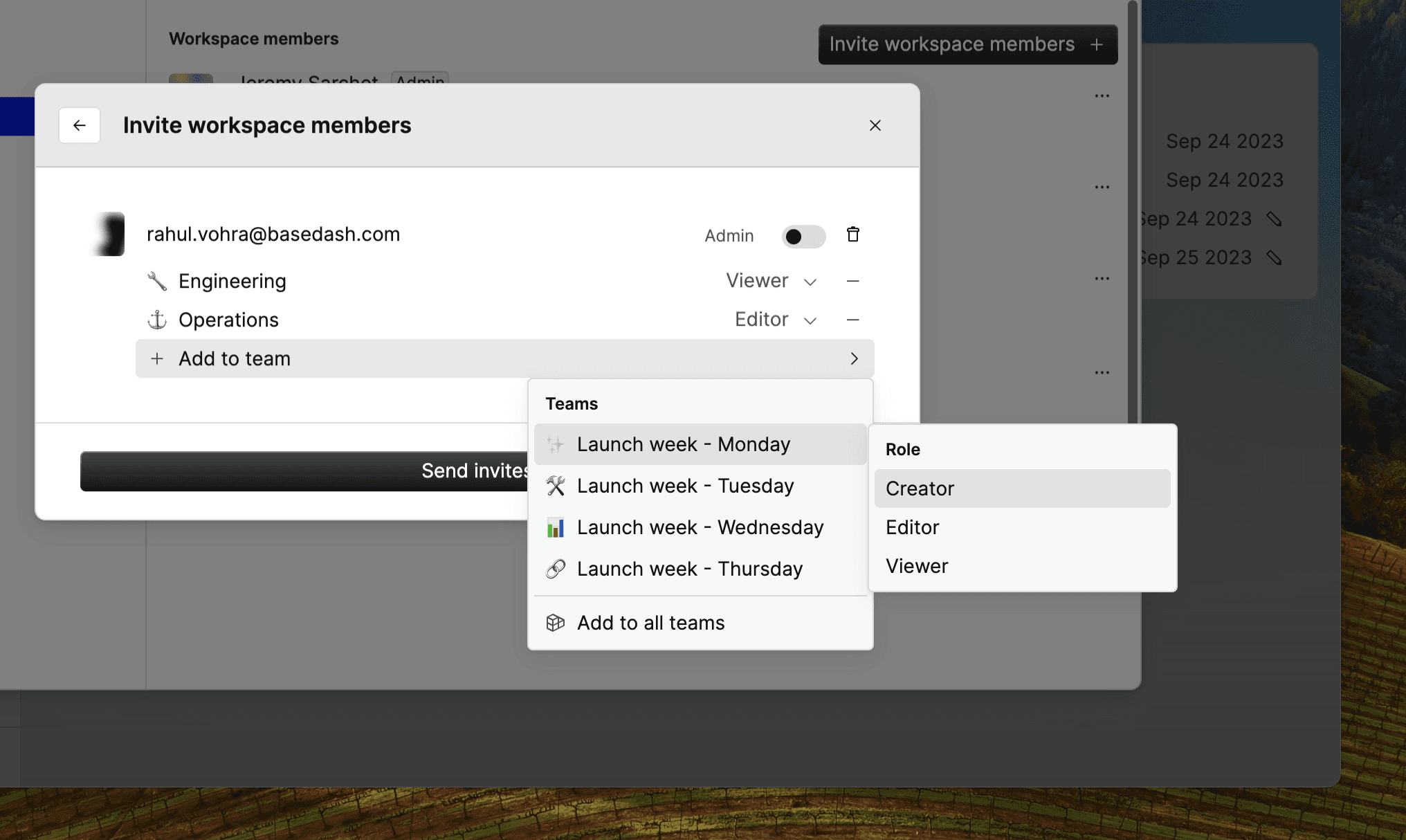
3. SAML SSO
We’ve enabled SAML SSO so you can control authentication and make sure that access for a user is revoked if, say, that person leaves your company.
SAML SSO is currently available on our Enterprise plan. Reach out to sales@basedash.com if you’d like to enable it for your workspace. Once we do, you can set it up by adding and verifying an email domain from your workspace settings and then copying several strings to and from your identity provider.
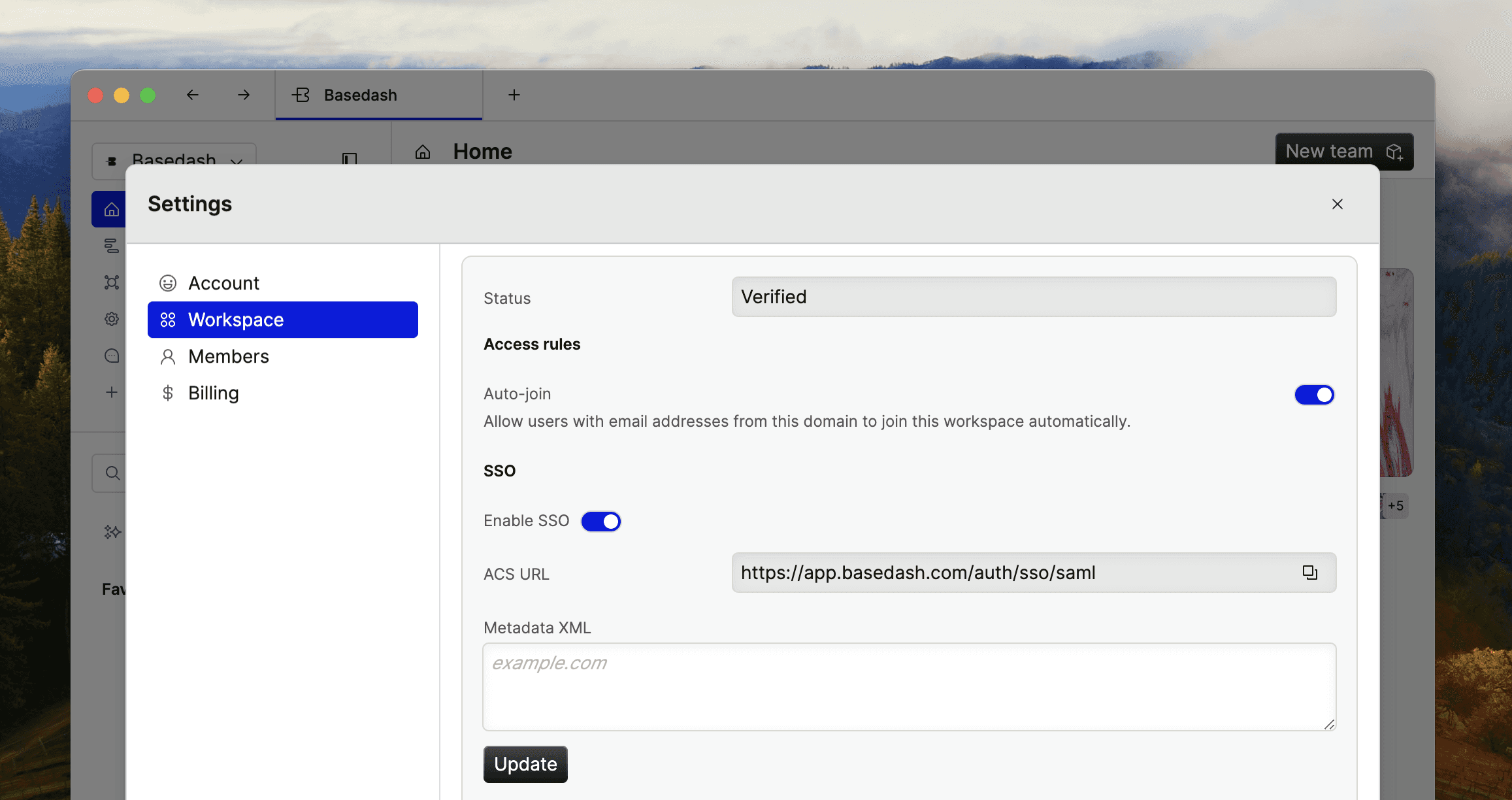
Sep 15, 2023
Feedback form, multi-line text editor
1. Feedback form
We added an in-app feedback form so that you can quickly share any feature requests or bug reports while using the app. Just click Feedback in the sidebar and share your thoughts. We’ll automatically capture which page you’re on as context for our engineering team.
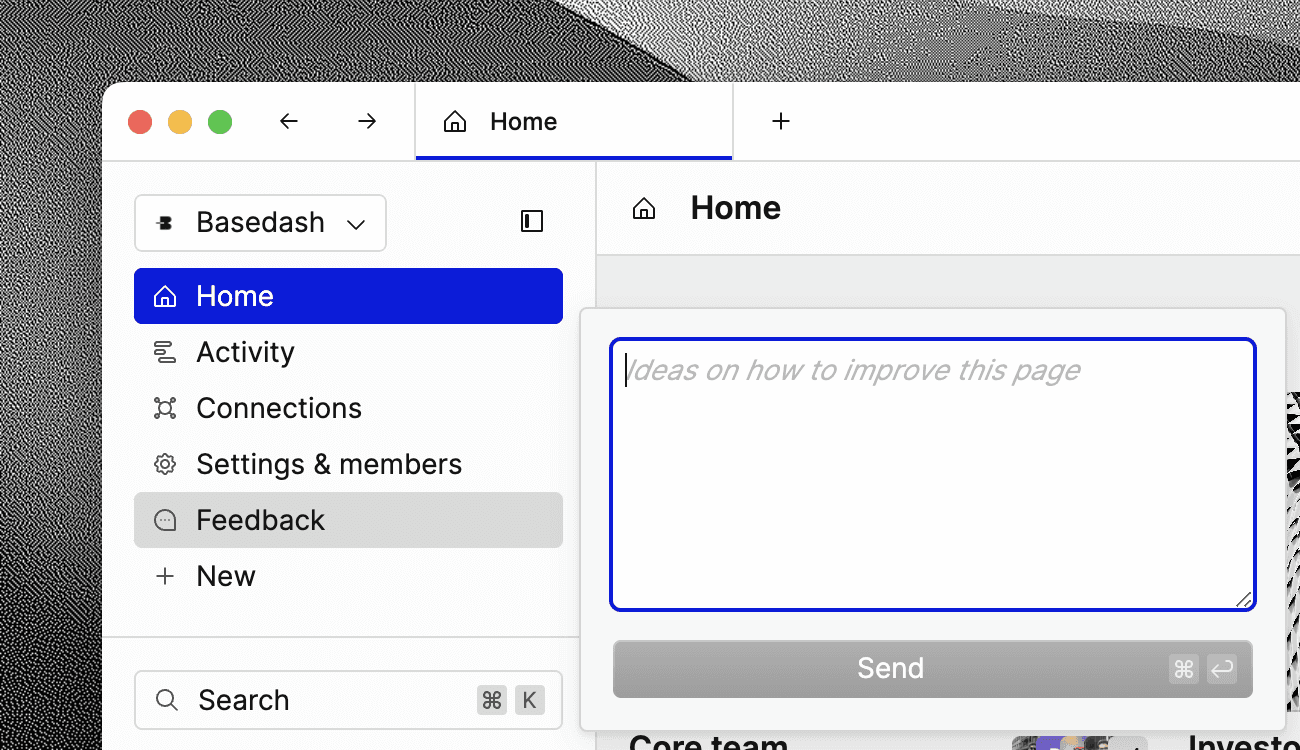
2. Multi-line text editor
We added the ability to expand any input into a bigger modal for an easier editing experience. This works great for long text content like blog posts, JSON values, or descriptions. You can expand any text input by hovering over the input and clicking the expand button.
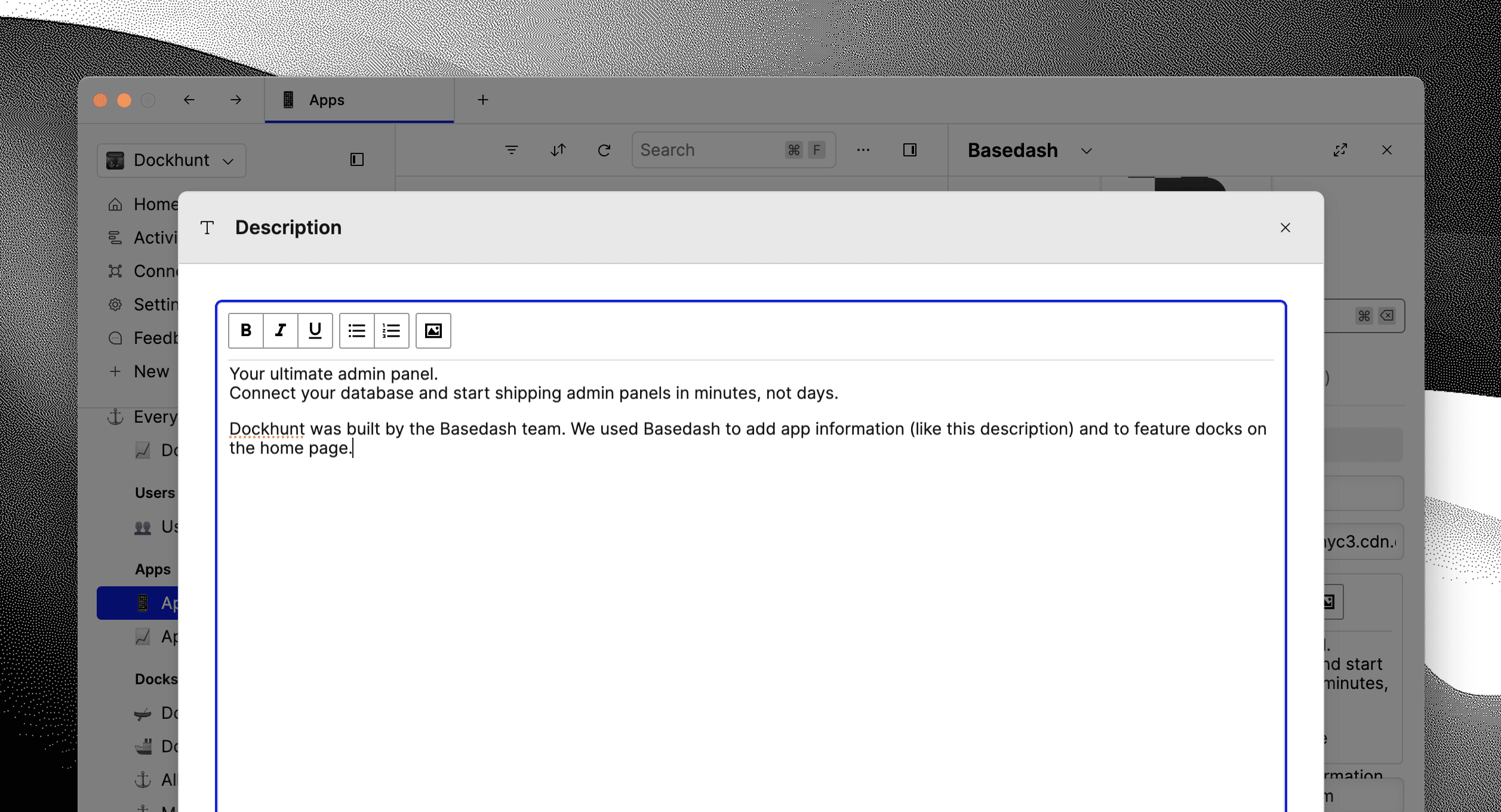
3. Bug fixes and improvements
Added new tab component
Added favorited page cards to the home page
Added record count to favorited view cards on the team page
Added ability for teams to be managed in the workspace invitation modal
Expanded maximum width allowed for record details panel
Updated JSON, rich text, and multiline text fields to be bigger by default
Improved empty state of connections page
Improved default workspace name using email domain
Improved consistency of card widths across the app
Improved styling of SQL query error messages
Improved styling of buttons
Improved styling of segmented controllers
Updated views to maintain edit state after navigation
Fixed sizing of foreign key inputs
Fixed new action button being visible outside of a team
Fixed record being deselected after creating a related record
Fixed backspace not working in foreign key dropdowns
Jul 25, 2023
Performance, segments, invitation
1. Performance improvements
We’ve significantly improved the performance around loading records throughout the app. This includes loading views, relations, foreign keys, and segments, where the record load time is now up to 10 times faster.
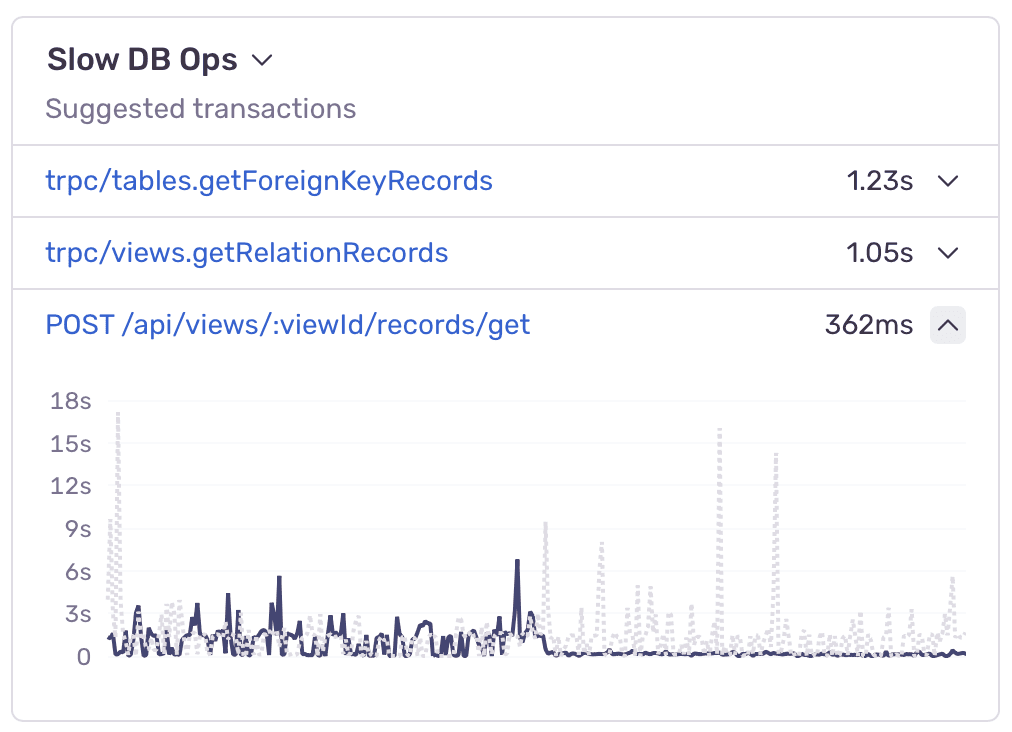
2. Segment improvements
Last month we shipped Segments in beta. This month we shipped some big improvements, including automatically suggesting new segments based on your current filters, and the ability to reorder segments in the side panel.
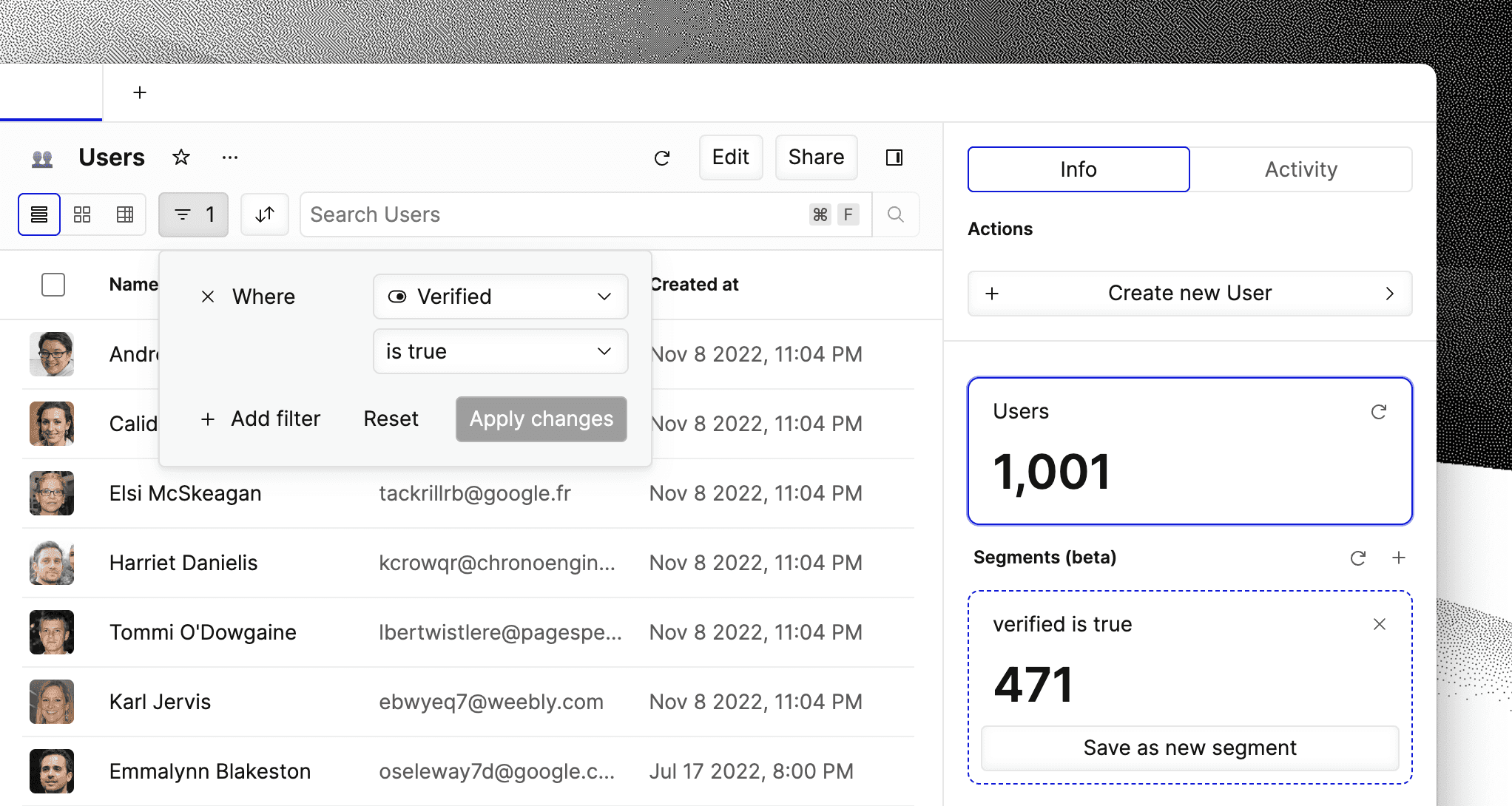
3. Redesigned invitation flow
We’ve totally redesigned the flow for adding new members to your workspace, optimizing for simplicity and speed. You can now choose which teams a member will be part of before they join your workspace.
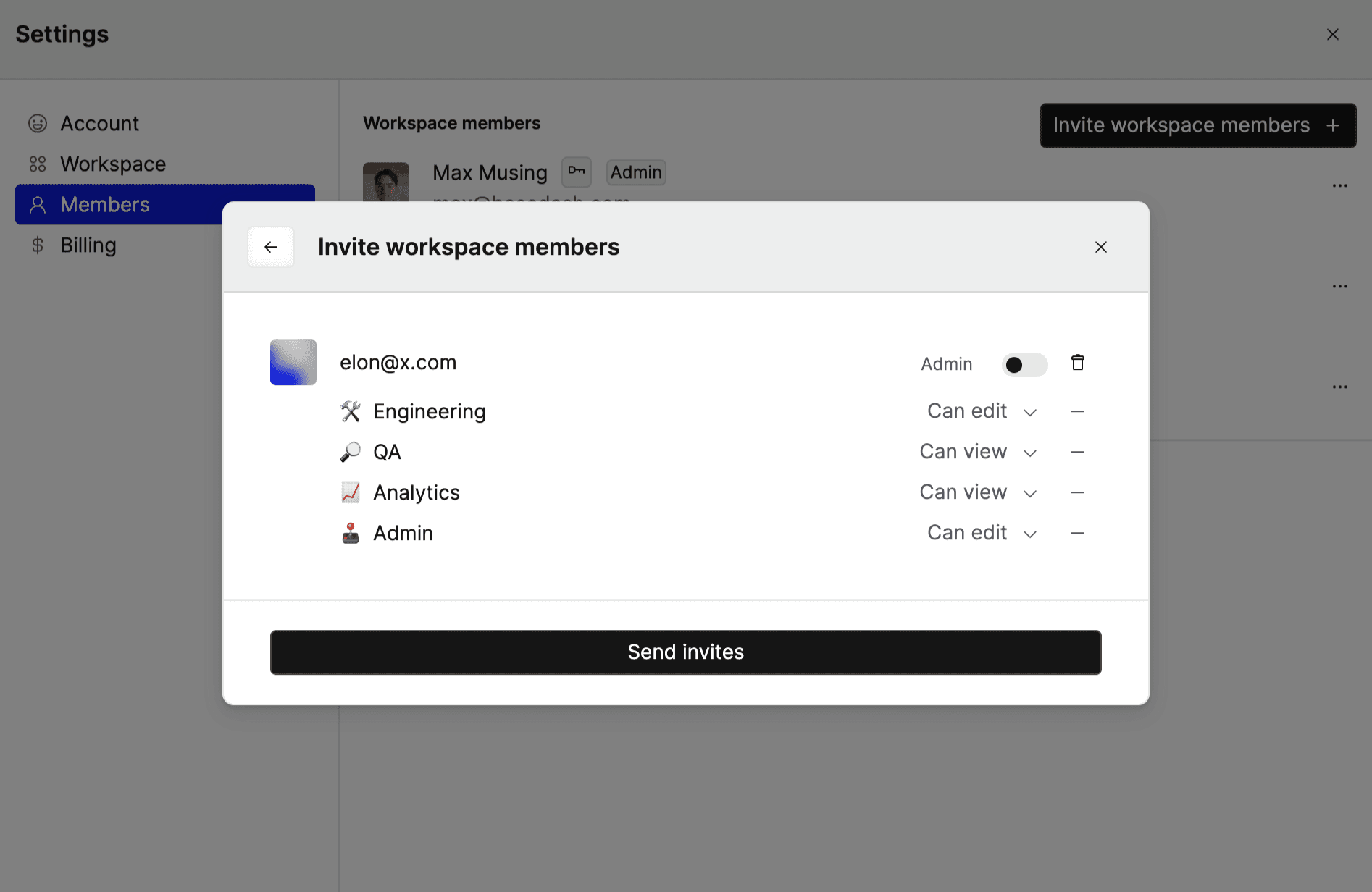
4. Bug fixes and improvements
Fixed the setup flow for TOTP MFA without a QR code
Improved keyboard shortcuts and responsiveness of the rich text editor
Added support for MFA in conjunction with SSO and Google authentication
Fixed upgrading while over the page limit for your current plan
Improved styling of presence avatars
Fixed some modals being too tall
Jun 22, 2023
Segments, SSO, activity
1. View segments (beta)
Within a view, you can now create a segment that lets you apply filters to load a subset of your records. This is great for things like recently signed up users, segmenting orders by status, or free vs paid workspaces. When you open a view, you’ll also be able to see how many records are in each segment.
Segments are in open beta today for all workspaces. You can create a segment from the details panel of a view.
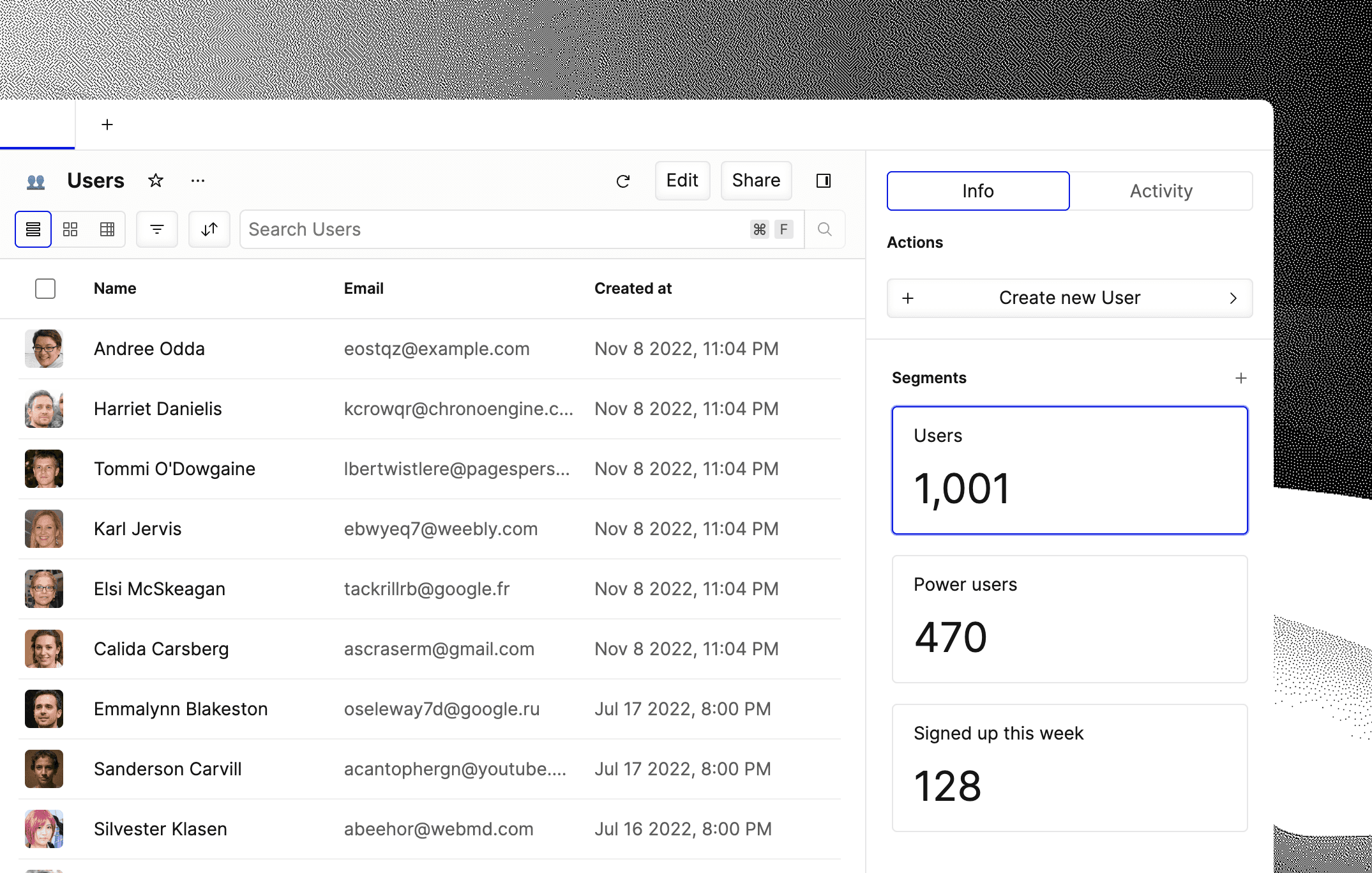
2. SAML SSO
You can now enable SSO authentication on your workspace using any SAML identity provider including Okta, Active Directory, Auth0, Rippling, and many more.
SSO is part of our Enterprise plan—if you’re interested, reach out for more info.
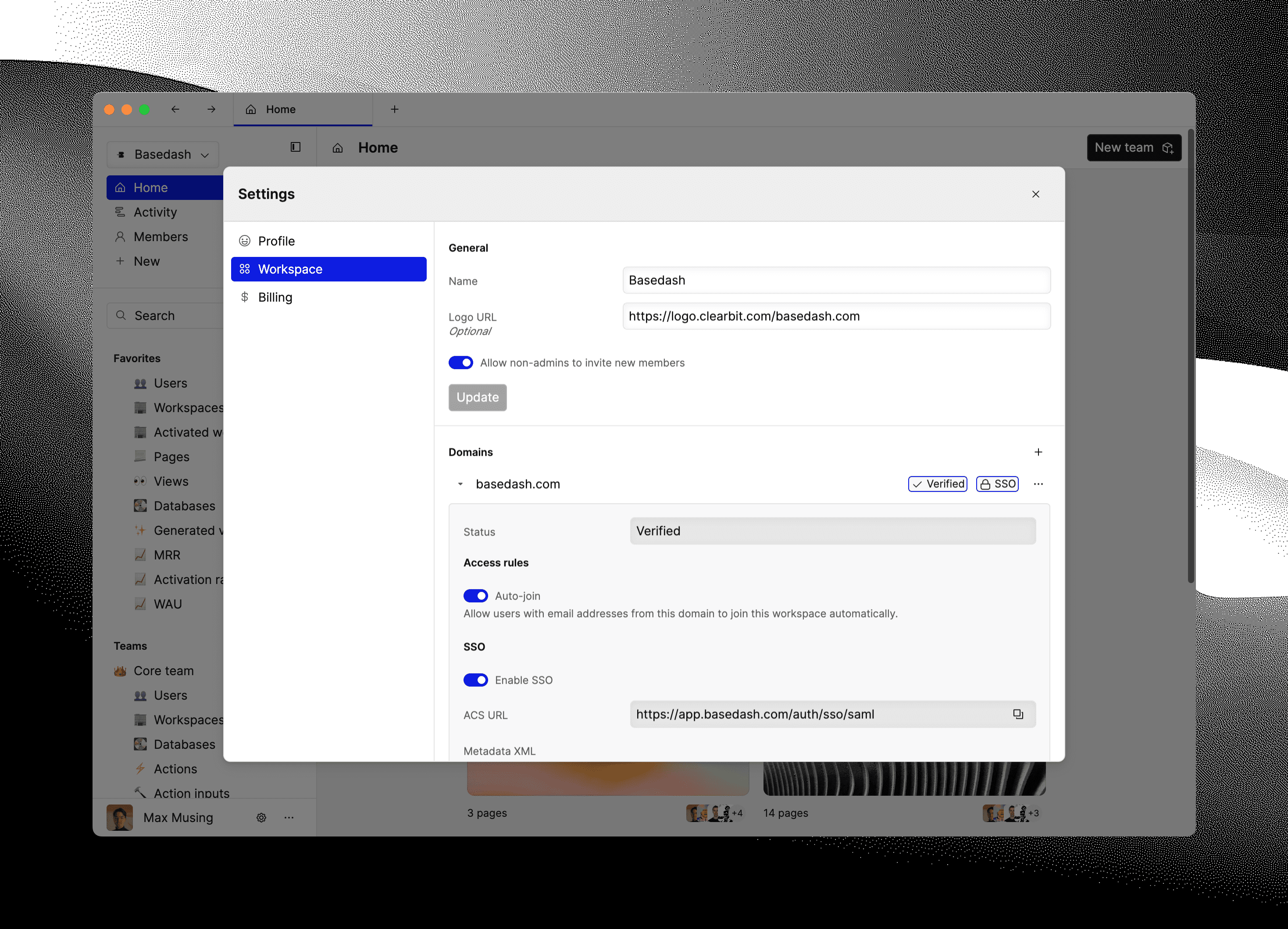
3. Activity redesign
We’ve introduced a totally redesigned activity feed that lets you see the complete history of any record in your database.
You can now also see any activity that’s happened within a specific view, like your users or workspaces.
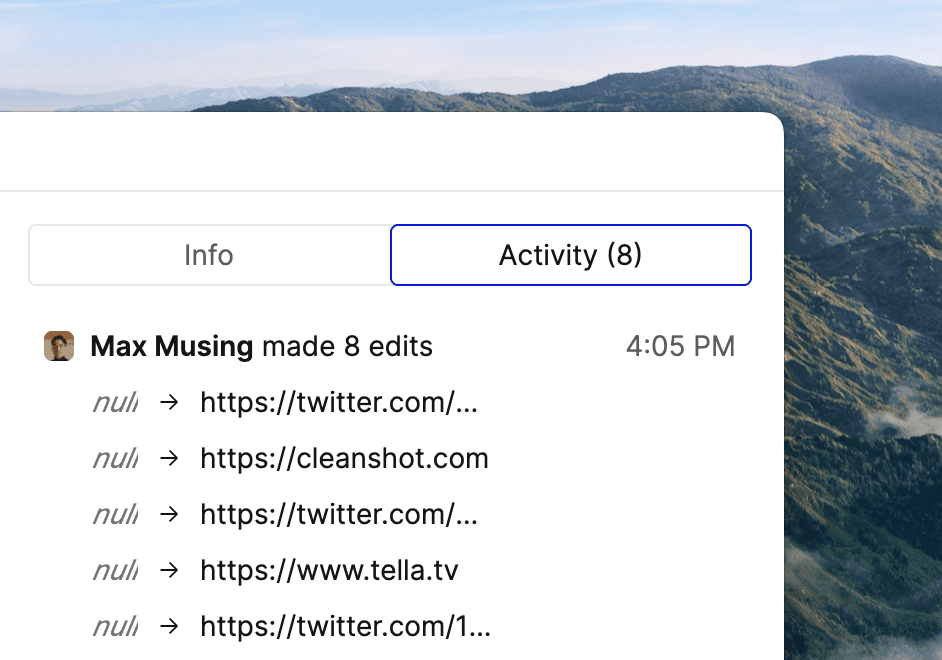
4. Bug fixes and improvements
Improved column resizing on tables
Updated avatars to be square
Fixed styling of table header icons
Improved keyboard navigation of record attributes
Improved styling of tabs in the desktop app
Improved icons on profile dropdown menu
Improved styling of checkboxes
Updated styling of foreign key dropdowns
Added icons to some dropdown inputs
Fixed account deletion flow
Added workspace invitation followup emails
Fixed text ellipsing behavior of rows in some lists
May 18, 2023
AI assistant for queries
We’ve added a new AI assistant for helping to debug SQL queries. When you run into an error in a SQL query, you’ll see a new “Ask AI how to fix” button. When you click it, Basedash uses GPT to diagnose the issue and show you a more detailed explanation of the problem, and a suggested fix. In most cases, you can directly copy-paste the fixed query to solve your issue. This feature is only available to paid users.
This feature is part of our ongoing efforts to integrate AI into Basedash everywhere we can to make your life easier. We have many more interesting AI features on the roadmap—if you’re interested in trying them out before they’re publicly launched, let us know by messaging the team in our Slack community.
Page organization
We’ve spent some time significantly improving the experience around organizing pages in your workspace. You can now click and drag to reorder almost anything in the sidebar, including pages, sections, and teams. You can also dragging pages between sections or teams, and even drag entire sections between teams.
You can also now right-click to open the dropdown menu on pages, sections, and teams. This is part of our efforts to add right-click context menus across the whole app.
User-level sorts
We’ve added user-level sorts to views, so you can now change the sort order of a view without affecting the view itself. You can apply these sorts by clicking the sort button at the top of a view.

Other improvements and fixes
Added ability to change attribute display names on individual views
Added indicator for the number of seats on the upgrade page
Added keyboard shortcut for deleting the selected record (
⌘⌫)Improved performance of removing a connection
Updated behavior when deleting a section to delete the contained pages
Updated teams to be initially expanded in the sidebar
Updated team creation flow to open the team home page after creation
Updated sections in record details panel to be collapsible
Updated visual styling of charts
Updated visual styling of action buttons
Updated view relations to not include the currently selected record as a related record
Updated visual styling of collapsible section headers
Fixed new filters not being applied immediately while in the view editor
Fixed positioning of dropdown menu on member list
Fixed long error message being shown when editing some date fields
Fixed weird behavior when pressing the space bar while editing action inputs or headers
Mar 13, 2023
Improved page management
We’ve made a huge number of improvements to how pages are managed in Basedash. We’ve unified page functionality across all page types (views, queries, actions), like being able to move between teams, add to Favorites, and duplicate. We’ve also unified the keyboard shortcuts for common actions on pages like copying the link or duplicating the page.
A lot of the changes we made are designed with the desktop app first, like tabs and keyboard shortcuts. If you’re a regular Basedash user, we recommend downloading our desktop app here.
Here’s a full list of the changes we made:
Added more options to the dropdown menu for pages in the sidebar
Added ability for page name and emoji to be edited inline in the action bar
Added ability for action pages to be favorited
Added ability to move action pages between teams
Added ability to set emoji on actions
Added keyboard shortcut for copying the current URL on desktop (⌘L)
Added keyboard shortcut hints in page dropdown menus
Added option to toggle favorite status in page dropdown menus
Added ability to reorder favorited pages
Added ability to duplicate actions
Added ability to open pages in a new tab on desktop by Cmd-Clicking on a page in the sidebar
Added dropdown menu for sidebar pages for non-admins
Improved view duplication to include relations
Simplified page URLs
Updated login + signup flow
We’ve updated the way we handle authentication to work with email-based magic links by default. This means that you no longer need to verify your email separately after signing up. You can still add a password to your account after signing up if you prefer to log in that way.
Redesigned emails
We’ve gone through and redesigned all of our transactional emails to look better and match the branding used across our app. The emails are now much easier to parse and take action on.
Other improvements and fixes
Added step during onboarding to configure workspace details
Added a spinner to view creation when a data source is syncing
Added keyboard shortcut for creating a new record on desktop (⌘N)
Added keyboard shortcut for reloading records in a view or query (⌘⇧R)
Moved ‘Run query’ button to the top bar
Removed back button from connection settings header on desktop
Updated font used in SQL query editor
Updated font used in charts
Updated chart text color to match branding
Updated SQL query editor line number text color to match branding
Updated chart legend to only be visible on charts with multiple data sets
Updated naming of “Primary attribute” to “Display attribute”
Updated connection configuration page to show raw database names for tables and columns instead of display names
Updated CSV exports to take into account user-level filters and searches
Increased CSV download limit from 1,000 to 10,000
Improved styling of upgrade callout in the sidebar
Improved styling of ‘Run query’ button depending on whether the query editor is expanded
Improved search bar experience on views and queries
Improved alignment of labels on switch fields
Improved performance of loading views on tables containing foreign keys or enums
Fixed padding around charts
Fixed joined tables section not always being visible in view settings
Fixed record deletion on views with joins
Fixed date filter dropdown sometimes being positioned incorrectly
Fixed updating credentials on data sources with failed connections not updating immediately in the UI
Fixed creating views on tables with composite foreign keys
Fixed editing actions
Fixed styling of buttons in date picker dropdown on light mode
Fixed views not being able to load data for some time after removing/renaming a column from the underlying database table
Fixed date formatting in activity feed
Fixed sidebar becoming unresponsive after deleting a team
Fixed record creation panel not being able to be closed when “Create more” is toggled on
Fixed view relations showing “Empty” when the related view contained a join
Fixed data source settings panel not loading for databases with multiple schemas
Fixed padding of ‘select’ and date inputs being slightly larger than other inputs
Feb 14, 2023
New query editor
We completely re-wrote our SQL query editor from scratch, using the same core editor that VS Code uses. This gives it powerful new features like multi-cursor, code completion, info on hover, and an intelligent scrollbar. We also updated the syntax highlighting themes to better match our branding.
Other improvements and fixes
Added a right-click context menu to table cells, with options to copy value or set as null
Added database indicator in query settings
Added ability to delete user accounts
Improved table search experience when creating views
Increased CSV export record limit from 100 to 10,000
Updated styling of pagination on views
Fixed query undo history being cleared after collapsing the editor panel
Fixed secondary link to cancel subscription on billing page
Fixed “obscured” setting not being visible on attributes
Fixed default query layout not being shown as table
Feb 7, 2023
Join improvements
We’ve made significant improvements to joins on views to support many more use cases for connecting data between tables.
First, you can now make arbitrary joins on your tables without the need for foreign keys in your database. This is especially useful for PlanetScale which doesn’t support foreign keys.
Next, we also now support nested joins, which let you join data across tables multiple levels deep. For example, you can create a view on “User”, which is joined through “Team”, which is joined on “Workspace”. This would let you get the name of the workspace that a user is part of.
Foreign key modal
We updated the way that foreign keys open their record details. Before, we used to open an entire table with filters applied to show a single record. Now, we open a modal with the record details nicely displayed as a form. This makes it easier to pop open the details, make changes if needed, then return to the original view.
As before, only workspace admins can open foreign key records. If you want to give non-admins access to nested data, you can join data on a view.
Manually run queries
We also added a simple option on queries to disable automatically running queries on open. This is useful for long-running queries, or queries that mutate data when run.
Other improvements and fixes
Added a confirmation dialog before deleting a section
Added option to add your own database right away during onboarding
Added option to add a connection from the “New” dropdown in the sidebar
Removed dismissible content on team pages
Improved performance of loading records in tables with over 1 million records
Improved app initial load performance
Updated styling of context menus to match dropdown menus
Updated private views to allow relations on views from other teams
Fixed sessions expiring randomly
Fixed connection credentials not showing as changed immediately after being updated
Fixed primary attribute icon background color
Fixed view relations not loading in some cases
Fixed loading spinner not being visible on buttons
Jan 16, 2023
Private pages
Today we’re introducing private pages, a new space to create pages for yourself without sharing them in a team. You can use the private section to create views that are only relevant to you, or to draft new pages before publishing them to a team. As an admin, you can move pages between your private section and a team whenever you want (via “Move to team” in the overflow menu on a page).
Only workspace admins have access to a private section since only they can create new pages. However, private pages can later be published to a team to share with other workspace members.
The addition of private pages means that we’re removing the old published/draft system for pages. If you have any existing draft pages, you can easily move them to your private section to limit their access.
Other improvements and fixes
Added transition to checkboxes in list layout
Updated styling of loading spinners
Removed desktop app prompt from sidebar
Updated background color of sidebar
Updated background color cards in card layout
Updated new page button to always be visible beside teams in the sidebar
Updated plus button on attributes list to always be visible
Updated all view attribute accordions to be open by default
Updated team badges in members page to show emoji
Updated view relations to auto-load immediately upon opening a view
Improved initial app load time by reducing bundle size
Improved error messages when deleting records fails
Fixed records with special characters in their primary key not being able to be updated
Fixed new page button being visible to non-admins
Fixed team row not being clickable
Fixed minor styling issue with sidebar padding
Fixed updating actions
Fixed resizing columns
Fixed actions not showing fields for non-admins
Moved link to Settings from the top of the sidebar to the bottom
Jan 4, 2023
Sidebar search bar
We’ve updated the search bar in the sidebar to open our command menu with a powerful search engine. You can search for any page by its name, section name, or team name, then quickly navigate to it completely with the keyboard.
You can also trigger the command menu with a keyboard shortcut (⌘K or Ctrl + K) to navigate or take action in Basedash in just a few key presses.
Record creation form customization
We added the ability to customize the record creation form so that you can hide certain attributes. This lets you simplify your record creation flow to only show the essential attributes for you and your teammates.
You can configure this by editing a view, selecting the “Form” layout in the sidebar, and changing the “Optional in form” attributes. After updating the form attributes, you can change the view back to your preferred layout before saving.
Removal of connection tables
In the coming weeks, we will be removing the ability to access tables directly through the connections page. You'll still be able to access all of your data through views and queries, with the added benefit of having full control of permissions through teams. You'll also be able to take advantage of layouts, actions, and relations.
This is part of a larger change that will simplify navigation with a single unified sidebar, and allow for more organization through manual reordering.
Newly created workspaces already have this change applied, so this will only affect workspaces created more than a month ago. Affected users will see an alert in the app notifying you of the upcoming changes.
If you have any questions about this change, or want help transitioning your current workflows, send us a message.
Other improvements and fixes
Added the ability to switch theme using the command menu (try ⌘K → ‘theme’)
Added dark mode for command menu
Added the ability to collapse the navigation sidebar
Added a search bar to the view creation modal
Added help text to when setting “primary attribute” on a table
Added the ability to remove Slack alerts
Removed record details sidebar from connection tables
Updated styling of command menu
Updated command menu to show team and section of a page for navigation
Updated default port for MySQL databases hosted on Google Cloud
Improved loading indication when opening a view or query
Fixed flash of “No records found” text when opening a view for the first time
Fixed editing filters and sorts on a view sometimes not working
Fixed some views crashing the app when opened
Fixed creating views on self-hosted deployments when an optional environment variable was missing
Fixed display image in list layout being slightly cut off on small screens
Fixed sidebar expand icon not appearing on views
Fixed placeholder display images not rendering
Fixed record details panel showing “Selected record” instead of the primary attribute
Fixed updating a profile photo not being reflected until refreshing the app
Fixed page names not showing in the team pages list
Fixed moving pages into a section if they were not part of a section before
Fixed some attribute labels showing as “undefined” in Slack notifications
Fixed updating records in SQL Server databases
Fixed “New team” button being visible for non-admins
Fixed some navigation commands in command menu linking to a 404 page
Fixed view limit not updating when deleting a team with views
Dec 12, 2022
Page overflow menu
We added an overflow menu to the pages in the sidebar to give you quick access to edit or delete a page in 2 clicks. This should make it much easier to manage your teams and pages within your workspace. We’ll be adding more features to the menu over time, like duplicating and renaming.
We’re working on more big improvements to the sidebar. Keep up to date by following us on Twitter or joining our Slack community.
Other improvements and fixes
Added the ability for non-admins to resize columns in views and queries
Removed onboarding checklist for non-admins
Changed behavior when creating a single view to immediately navigate to it
Fixed page limit not being freed up when deleting a team
Fixed view relations for views with no list layout attributes
Fixed image warping on connection logos
Fixed JSON content being cut off
Dec 5, 2022
Bulk view creation
We’ve totally revamped the way you create new views to allow for bulk view creation. This means that you can select multiple tables from your database, and we’ll automatically generate views for them all. This makes the initial setup process of a new team much faster and smoother.
You can try it out in two ways:
Create a new team. The initial state of the team page will let you create views.
Add new views to a team. You’ll see a modal that lets you create views from your database.
We have more improvements planned for bulk view creation, so keep your eye out on our changelog. To keep up to date, you can follow Basedash on Twitter, and join our Slack community where we post updates, share access to beta features, and listen to your feature requests and bug reports.
Other improvements and fixes
Added the ability to edit and delete pages directly from the sidebar
Fixed workspace switcher sometimes being unreliable
Fixed moving pages to other teams when they were originally part of a section
Fixed web app crashing in some cases where there was a mismatch in cache state
Fixed creating Slack alert subscriptions from the desktop app
Fixed search history not closing after applying a search
Fixed views disappearing from the sidebar after being edited
Nov 25, 2022
View relations (beta)
We’re excited to announce a beta release for view relations. View relations allow you to connect data together across different tables—or even different data sources—to easily see which records are related to the currently selected record. Once you create a relation on a view, you’ll be able to see a list of records related to the selected record in the right details panel.
For example, with view relations you can show:
Users in a selected workspace
Orders made by a selected customer
Products made by a selected manufacturer
Variants of a selected product
Anything else you can think of
Check out the full docs here: https://docs.basedash.com/views#31539877ad05480aad2cb91337fc6713
See how it works in a quick video demo:
Redesigned sidebar navigation (beta)
We completely redesigned the sidebar to simplify navigation and allow you to quickly jump between pages, no matter where you are in Basedash. Along with this change, we also renamed “Apps” to “Teams”. Now, your teams appear as folders in the sidebar, letting you easily access the pages within.
Alongside the changes to the sidebar, we also made the decision to remove the raw table editor from Basedash. You can still create views of your database in the table layout, but nothing is created automatically after connecting a database. This change aligns the new user experience with our intended primary value of Basedash.
Because these changes are significant and remove some functionality, they have not yet been applied to existing workspaces, only newly created ones. If you want to upgrade your workspace to the new design, send us a message in the app, or in our Slack community. We plan to migrate all existing customers in the coming months.
Other improvements and fixes
Added team membership indicators on the members page
Added the ability to create multiple views at once after creating a new team
Updated searches to save to the URL for sharing
Improved default attributes visible on views using AI
Removed members page in apps in favor of directly opening the members modal
Fixed searches not being cleared when switching between pages
Fixed filter values being reset when changing the filter column
Fixed HTML rich text editor not being able to be saved
Fixed views becoming temporarily hidden in the sidebar after being edited
Nov 15, 2022
PlanetScale support
We’re excited to announce first-party support for PlanetScale as a data source.
PlanetScale is a high-performance MySQL-compatible database platform. With Basedash, you can build fully-featured admin panels on top of your PlanetScale database in seconds. This lets you build things like user dashboards, order management tools, or approval workflows in a few clicks. Everything you build in Basedash is shareable with your team, with full permission controls at your fingertips.
To connect a PlanetScale database, create a new connection in Basedash and select “PlanetScale” as your database. You can retrieve your connection credentials from the PlanetScale dashboard for easy connection to Basedash, with full read-write capabilities.
Once connected, you can create views to allow certain tables to be viewed and edited, and also write SQL queries directly against your database. Both views and queries can be shared with teammates with either view or edit access.
Basedash also supports PlanetScale Boost for ultra high performance queries. Any SQL queries you write in Basedash that match a query that you’ve cached in PlanetScale will be boosted. For now, you need to manually enable Boost cached queries on your database connection by running the following SQL query in Basedash: SET @@boost_cached_queries = true;
Search history
We now save search history within views so that you can easily go back to previous searches. We also now persist your search query on a view when you switch pages and come back. This makes it much easier to jump between pages and cross-reference data.
Other improvements and fixes
Added the ability to transfer workspace ownership to another member
Added a footer to the sidebar with user info
Added support for MySQL timestamps
Added dedicated Members pages within workspaces and apps
Added activity logs for record creation
Added ability to move pages to another app
Added tooltips with keyboard shortcuts on more sidebar items
Added the ability to save a partially-created action
Added the ability to partially select text in table cells
Added a workspace switcher on mobile
Added a demo Postgres database to all new workspaces
Improved styling of list layout header
Updated filters to maintain value if possible when switching columns
Updated the search bar to retain its value after changing pages and closing the app
Updated onboarding to automatically create a workspace on signup
Updated Slack alerts to only show the attributes selected on the active layout of the view
Updated styling of toast for updating the app to be less intrusive
Fixed new Slack alerts not being able to be created
Fixed page limit not being applied in some cases
Fix loading data from tables that use object-based primary keys
Fixed onboarding flow for Google signups
Fixed recent search not being cleared after clearing search bar
Fixed issues with avatars not being perfect circles
Fixed API settings automatically saving when clicking on a header
Fixed changing connection names
Renamed “History” to “Activity” in record details
Removed “Pages” section header from app sidebar
Oct 24, 2022
Database connection URIs
You can now connect a database way faster by just pasting in a single connection URI from your hosting provider. We’ll automatically parse the connection string and fill out the individual field components so you don’t have to.
Onboarding checklist
When you create a new workspace, we’ll now show a simple onboarding checklist so you always know the next step to improve your apps and views. Each step has instructions, docs, and videos to explain how to move forward with setting up your workspace.
AI-generated view emoji
When you create a new view, we’ll now automatically choose a relevant emoji to represent your view and make it recognizable. We’re using GPT-3 to choose an emoji based on the name of your view’s base table.
Other improvements and fixes
Added ability to transfer workspace ownership to another member
Added ability to dismiss app update toast
Improved security of API headers
Updated layout of view header bar to give search more room
Updated styling of app card borders
Moved the profile dropdown to the bottom of the sidebar
Fixed attributes marked as uneditable not being able to be set during record creation
Fixed attribute syncing after changing a database column to nullable
Fixed Slack alert notification creation
Fixed actions not appearing in the sidebar immediately after creation
Fixed appearance of apps with no cover image
Fixed record edits being applied multiple times in some cases
Fixed long foreign key values being cut off
Fixed removing filters sometimes removing the incorrect filter
Fixed positioning of attributes popover for tables with many columns
Fixed some avatars appearing as ovals instead of circles
Fixed attributes still appearing in views after being deleted in the database
Oct 17, 2022
App templates
When you create a new app, we’ll now suggest some templates to give you ideas of the kinds of apps you can create. For now, they set the name, image, and icon of the app—in the future, we may use the templates to make even more suggestions on the kinds of views or actions you can create within the app.
Automatic record images
When you create a view, we’ll now automatically look for any columns that store URLs to images, so that we can show the image inline in your new view. That makes it way easier to create beautiful list or card-based views of your database.
You can always set the display image attribute manually in your view settings.
Other improvements and fixes
Updated default view names to be humanized
Added a workspace setting to prevent non-admins from inviting new members
Added a CTA to upgrade when nearing your plan’s page limit
Improved onboarding sequence to speed up time before creating an app
Oct 6, 2022
Vertical card orientation
We’ve added a new orientation to card layout that lets you stack an image from your database above any important information. It’s perfect for any image-heavy data, letting you quickly navigate through your records. You can fully customize the image and data that shows up on each record’s card, and independently control which attributes are visible and editable in the side panel.
You can switch between vertical and horizontal card orientation when creating or editing a view.
Action history
You can now view the run history of any action directly on the action page. This lets you see every time that an action has been run by you or your team, along with the details of the input values and API response.
For more information about actions and what you can do with them, check out our docs: https://docs.basedash.com/actions
Other improvements and fixes
Added ability to delete app sections
Added support for editing interval columns
Added inline warnings to the action creation page
Added support for self-hosting on AWS ECS
Added an error message for SQL queries that time out
Added workspace switcher to new workspace onboarding flow
Added indicator to show which trigger was clicked when opening a popover
Added ability to run draft actions from the action builder
Simplified signup form
Improved database sync performance
Improved signup page for joining the demo workspace
Updated tooltip copy on the “Publish” view button
Updated styling of list and card layouts to have a maximum width
Fixed alignment of switch inputs
Fixed button to remove filters sometimes not working
Fixed “New record” button appearing on uneditable pages
Fixed disconnected tables showing on the connections page
Fixed duplicating queries to redirect to the newly created query
Sep 13, 2022
Improved desktop tabs
We’ve improved tabs on the desktop app even further, by allowing you to open multiple tabs of the same app. This lets you easily cross-reference views or actions in the same app for complex workflows.
You can open a new tab by clicking the new “+” button in the tab bar, or by holding Ctrl/Command when opening an app from the Home page.
You can download the Basedash desktop app for Mac, Windows, and Linux here: https://www.basedash.com/download
Other improvements and fixes
Added a history pane to the action editor
Added a separate “Save” button in the action editor
Added an improved empty state for lists that support adding and removing entities
Added number indicator to History tab in record details panel
Added actions to record history panel
Added tooltips with keyboard shortcuts across the app
Added more information to action history items
Added “Share” button to database tables
Added support for line breaks in action descriptions
Added support for Slack notifications on self-hosted setups
Added support for Google sign-in on self-hosted setups
Added support for self-hosted AWS ECS deployments
Fixed links in emails for self-hosted deployments
Fixed loading spinner appearing after resizing a table column
Fixed tab location resetting in some instances
Fixed deleted views not disappearing from the sidebar for other users in the workspace
Fixed duplicated views not being added to the correct section
Fixed action inputs not updating immediately
Updated display images to show a placeholder for records with undefined values
Improved the performance of load times for re-opening views that have been opened recently
Removed the limit on number of apps based on plan
Renamed “collection page” to “view”
Aug 16, 2022
Record-level activity
You can now see edits that have been made on a specific record. Just select the record in a collection page, then switch to the “History” tab in the panel on the right. You’ll be able to see a list of recent edits including the person who made the change, the before and after value, and the time the change was made.
Desktop app tabs
On the Basedash desktop app, you can now open apps as tabs to easily navigate between them. You can also switch between them with your keyboard by pressing Ctrl/Cmd + 1-9.
You can download the Basedash desktop app for Mac, Windows, and Linux here: https://www.basedash.com/download
Drag pages between sections
You can now click and drag to move pages between sections in an app. This makes it way easier to organize your apps just the way you want them.
You can create a section by clicking “New” in the sidebar, then “Section”. Once you have multiple sections, you can simply click and drag a page to a new section.
Share button
We added a Share button on all pages within an app so that you can easily see who has access to the page, copy the link, and invite new members to your app.
Other improvements and fixes
Added the ability to include links in page descriptions
Added a button to the date picker to select the current date
Added a button to the date picker to clear the value
Added a button to return to the Apps launcher from within an app
Added support for non-admins to sort collection pages
Added user-level persistence of sorts on collection pages
Added the ability to rename workspaces from settings
Added the ability to update workspace logos from settings
Added an indicator showing the number of pages in an app
Added template cover images when creating and editing apps
Added a link to download the desktop app from the profile dropdown
Added new content explaining page types when you create a new app
Added a new email alert for getting invited to an app
Improved performance of loading action-related data
Improved responsiveness of form fields at small screen sizes
Updated the behavior for opening apps on the web to not open a new tab
Updated styling of login and signup pages
Updated opening animation of modals
Fixed running actions with interpolated values
Fixed editing joined attributes on collection pages with joined tables
Fixed database tables not appearing in command bar after opening and closing an app
Fixed a bug where the page limit would be hit before reaching the full limit
Fixed help text on switches being squished
Fixed app members with edit access not being able to edit some data
Fixed sorting on database tables
Fixed action inputs not being cleared when navigating between actions
Fixed some optional attributes not being able to be hidden from collection pages in form layout
Fixed duplicating pages in an app
Fixed loading spinner appearing excessively on collection pages
Jul 26, 2022
Summer 2022 release
We’re excited to release our biggest update ever to Basedash. We’re introducing two new major features, along with many other smaller features and improvements.
We made a quick 5 minute video showing off the full process of building an internal app with actions.
We’re also live on Product Hunt with these changes, join the discussion here: https://www.producthunt.com/posts/basedash-apps-actions
Apps
Apps are a new way to organize your views + queries. Each app can have its own set of members, so you can create one for each team in your company. You can also create sections within apps to organize your pages further.
With apps, we’re now letting different teams within the same company work together, while still providing robust permissioning and access controls. Some ideas of apps that you can create:
Engineering
Support/CX
Sales
Investor metrics
Content moderation
Actions
With actions, for the first time, we’re expanding Basedash beyond the database.
You can create actions to integrate with any third-party service with an API. You and your teammates can trigger actions to call an API (either internal or external) with the click of a button. Actions can also be triggered on database records, allowing you to take action directly on your data.
Before creating an action, you need to create a connection to an API. We have some templates for common third-party APIs, but you can always add your own.
Some ideas of what you can do with actions:
Send an email to a user through SendGrid
Refund a purchase on Stripe
Trigger a workflow on Zapier/Make
Update records through your internal API for complex validation
Create an order on Shopify
Update a customer on Salesforce/Hubspot
Other features
Pricing
We’ve updated our pricing to remove the limit on number of members and number of connections. You’re now free to add as many members as you’d like on any plan, including the free plan.
See our updated pricing page here: https://www.basedash.com/pricing
Sections
You can add sections to further organize your apps. Sections contain pages, and show up in the sidebar so you can easily find the page you’re looking for.
Form layout
We added a new layout type that only allows users to create new records in a database table. When this layout is selected, all other layouts will be disabled for that collection page (to prevent viewing and editing of existing data).
Display image
You can now explicitly set a display image on your collection pages. This image shows up in both list and card layouts, as well as in the record details panel. This is incredibly useful for data that revolves around images, such as users, products, properties, or companies.
Collection page description
You can now set a description on a collection page, which will show up in the record details panel when no records are selected. You can use this to describe how a collection page should be used by users.
Collection page permissions
You can now set certain permissions directly on a collection page:
Record creation
Record deletion
Record editing
CSV exporting
These are all enabled by default, but you can disable them by editing a collection page and navigating to the “Info” tab.
Sidebar search
You can now search for pages directly from the sidebar. Just hit ‘/’ and start typing to filter items in the sidebar.
Other improvements and fixes
Improved responsiveness of fields
Fixed some hidden attributes still appearing when creating a record
Updated command bar to allow navigation to pages within an app
Fixed loading spinner showing on collection pages unnecessarily
Updated styling of login and signup pages
Updated animation of modals and dialogs
Improved precedence of keyboard shortcuts depending on focus
Added link for new users to join the demo workspace directly
Added an empty state to list and card layouts
Added information about when a collection page was created and last updated
Changed the default collection page layout from table to list
Improved styling of date picker in dark mode
Improved layout of rows in list layout
Removed restriction of primary attribute always showing as the first column in a table
Improve interface for adding and removing attributes in a collection page
Update styling of switch inputs
Added new icons to some inputs
Removed roles. Apps provide all the same functionality, plus allow for more organization of pages
Improved support for collection pages with many columns
Improved stability of keyboard navigation in list and card layouts
Added field to set an icon on collection pages and queries within edit mode
Removed navigation footer on mobile
Jul 4, 2022
Connection summary
After connecting a database, we now show you all the steps we take to humanize your data in Basedash, including setting primary attributes, obscuring personally identifiable information, and prettifying table and column names.
You can review your database schema, and compare the humanizations made in Basedash. Note that we don’t make any changes to your database schema itself, just the way it’s
Sidebar search
You can now search the contents of any sidebar in the app to quickly find the page you’re looking for. You can also focus the search bar immediately with the keyboard shortcut “/”.
Other improvements and fixes
Added tabs to view settings sidebar
Added the ability to delete records on tables with no primary key
Added support for real-time avatar list of more than 3 users
Moved view icon switcher to view settings
Moved query icon switcher to query settings
Moved ‘remove connection’ flow to a modal from the connection settings
Updated URL paths for connection-related pages
Updated styling of outlined buttons
Fixed workspace switcher text color
Fixed the activity page crashing the app in rare cases
Fixed accessing favorited views from the Home tab
Fixed connections not being removed after being deleted by another user
Fixed roles not being removed after being deleted by another user
Fixed new connections not immediately appearing in the sidebar
Jun 13, 2022
Card layout
We’re excited to launch our third ever layout type for views. It’s called Card layout.
Card layout is great for data that revolves around images, like users, companies, and products. It shows each record as a card with a prominent image and any other important info that you choose to be visible.
We think that card layout fits in nicely with our other two layouts, table and list, in letting you build the perfect admin dashboard for your data.
Try it out by creating a view and selecting “Card” as the layout. You can get an image to show up by clicking an image URL attribute in the view settings sidebar, and setting “display as” to image.
List layout images
Like with Card layout, you can also now show images in your list layouts. They’ll show up in the list so you can easily identify records based on their image.
Page descriptions
We also added quick descriptions to each top-level page to describe how each primitive in Basedash works. You can jump straight to the docs page for each page, and see quick video tutorials on how to do basic tasks.
Other improvements and fixes
Added animations and transitions to various components
Added a progress bar to the welcome flow
Added a progress bar to the new connection flow
Improved the flow for trying to create view when at the limit
Improved feature flag system to allow users to access beta features
Improved placeholder UI for home page favorite cards
Updated styling of buttons
Updated cards on home page to use the view’s base table name instead of “records”
Updated list layout to allow any column to be shown first in the list
Updated placement of “Update credentials” button
Fixed views from the old workspace showing up after logging out and logging in as a new user
Fixed persistent loading screen when trying to load a workspace that no longer exists
Fixed alignment of traffic light icons on macOS desktop app
Fixed table column header width sometimes not matching the rest of the column
Fixed attribute dropdown in filter popover being too big
Fixed Basehash font not loading for obscured attributes
May 23, 2022
Creation and deletion permissions
You can now set permissions on individual views to prevent record creation and deletion. This lets you create views for members of your team that should only have access to certain actions on your data.
You also still set database-level permissions to limit view and edit access on specific tables or columns.
Other improvements and fixes
Fixed tabbing through records in the list layout
Fixed filtering on UUID columns
Fixed button styling when adding a connection
Fixed crash when navigating from one query to another
Fixed password in credentials page not showing the correct value
Improved error message when attempting to update credentials
Updated indentation on connections sidebar
Removed auto-focus on the first record in list layout
May 12, 2022
Improved list layout
We introduced the List layout last year, as our second ever layout type (after the humble table). This week, we’re shipping big improvements to the list layout that make it much more functional and beautiful.
First, we totally revamped the visuals of the list layout to make it look nicer. This includes better hierarchy, improved text styling, and cleaner element spacing.
Then, we improved the responsiveness of the list by allowing elements from a single record to stack. This makes the list layout experience much nicer on mobile, but also lets you expand the record details to take up the majority of the canvas on desktop.
Finally, we added the ability to select all records from the list layout for easier mass deletions.
Let us know what you think about the new list layout improvements in our Slack community here: https://www.basedash.com/community
UUID support
We also added better support for tables that use UUIDs as their primary key. Now, when creating a record in one of these tables, we’ll automatically generate a UUID to use as the primary key. You can always override the value with your own if need be.
Other improvements and fixes
Updated styling of the top bar on desktop
Fixed foreign keys and enums not loading when starting a session on a view
Added pagination to activity page
Updated “favorite” icon
Updated view layouts to be user-specific preferences, rather than tied to the view
Fixed deleted views & queries still showing in the sidebar
Improved performance of favoriting views & queries
Updated tables to show their display name in the header, rather than the raw name
Fixed some views not showing up when adding views to a role
Added the ability to edit values in views with joins
Improved email sequence showing off features for new users
Fixed link to record from edits in the activity feed
Changed ordering of views to put published before drafts
Added database-specific icons in the Connections page sidebar
Fixed icon on tables
Added icons to profile dropdown
Fixed boolean filters showing an unnecessary dropdown
Improved responsiveness of inputs in record details panel
Fixed redirection to welcome flow when trying to access the signup page while already authenticated
Fixed reloading records not showing a loading spinner
Fixed sidebar not showing tables immediately after connecting a database
Improved styling of list items in Roles settings
Added ability to add roles to a view from the view’s settings
Enabled SSL by default on Supabase databases
Apr 25, 2022
Record creation form
With the introduction of our new details panel last month, we decided to make use of it and improve the record creation experience.
The old method of creating records had a couple issues:
It was only possible through the table layout
It didn’t work for views where a required column was hidden
It required a lot of horizontal scrolling for tables with many columns
Our new method puts the record creation experience in the details panel, in a simple form. We split the attributes into two sections: Required and Optional. This makes it easy to skim through just the required fields to quickly create records.
We also added the ability to “Create more”, which keeps the record creation form open, allowing you to create many records in quick succession.
As usual, the feature includes full keyboard navigation and was built with accessibility in mind.
Other improvements and fixes
Updated default for Supabase databases to have SSL enabled
Fixed alignment of tooltips with content
Fixed deleted views appearing in view creation UI
Fixed null booleans not being editable
Apr 18, 2022
New filtering system
We’ve implemented a new system for how filters are applied and persisted for views for different users. This involves a few different changes:
Filters applied from a view no longer alter the root filters on the view, they only apply for the current user
These non-root filters can be applied by any user, regardless of permission level (e.g. Admin, Can edit, Can view)
Non-root filters are persisted across sessions per-user
Non-root filters can be easily reset
Non-root filters are applied to the URL, so you can easily share your current filters with your teammates
Together, these changes mean that anyone can explore data on their own within Basedash, without inadvertently affecting what other users are seeing. We think that this will open up the ability for users to more freely explore and edit data as needed.
Other improvements and fixes
Added interface to show member limit when inviting a member
Updated demo database
Fixed Slack alerts
Fixed views not being able to be created in some cases
Fixed table layout UI for views with large row heights
Improved responsiveness in views and collections
Improved responsiveness of record details panel
Improved error messages when data fails to load
Improved filtering UI for enum columns
Improve error messages when connecting a database
Added Easter egg in changelog
Apr 4, 2022
Improved Views and Data pages
Today we’re shipping a brand new experience to the Views and Data pages that shows you all of your views and collections in a searchable list, complete with full keyboard navigation. Before today, this list was only available after searching, but now the list will show up by default when you open the page.
You can take actions on views directly like favoriting, or right click on a view to quickly edit or delete it.
We’ve also added a Recents section so that you can quickly open up a view or collection that you had open recently.
Improved mobile responsiveness
From early on, we decided to build Basedash to support mobile devices, so that you can quickly monitor and make quick edits on-the-go. While mobile doesn’t make up the bulk of usage, it’s really important for use cases that come up every once in a while.
We just made a big update to our UI responsiveness to improve the experience on mobile. That includes:
Updated breakpoints for key UI changes
Full-width sidebar
Addition of workspace switcher
3x faster startup performance
After some deep digging into our app startup code, we managed to speed up the startup time for the app by 3x. This means that you’ll be able to jump into views and start editing way faster than before.
Performance is one of our top priorities while building Basedash. If you notice anything that doesn’t feel lightning fast, please let us know in our Slack community.
Other improvements and fixes
Added confirmation dialog before deleting records
Added record details panel to view settings
Added support for filtering on enum columns
Added support for tables with primary composite keys
Added support for tables with no primary key
Updated sizing of various UI elements across the app
Updated SQL views to reset pagination after re-running a query
Improved styling of JSON and rich text cells in table layout
Fixed bug preventing editing of the first cell when creating a new record in table layout
Fixed record details header appearing on view creation page
Fixed view limit callout not being shown when at the limit
Fixed “Connect a data source” CTA not being hidden immediately after connecting a data source
Fixed logging out causing a redirect loop
Fixed new record row not showing “default” on columns with default values
Fixed markdown cells removing consecutive line breaks
Mar 30, 2022
Improved details panel
Last year, we introduced List layout to Basedash, which is an alternate way of viewing your data as a simple list, with a panel for viewing details and editing the record. Today, we’re shipping a suite of improvements to the details panel.
First, we’re adding the panel to the Table layout, and tables in the Data tab. With List layout, we were forced to design an interface for editing the data of a single record. After using it in List layout for a year, we realized that the form-based layout would be equally valuable in Table layout, where vertical screen real-estate is limited.
Next, we added the ability to resize and collapse the panel. We didn’t want to force the panel to take up horizontal screen real-estate on all views, so now you can decide when you want it open, and how much space you want it to take up.
Finally, we cleaned up the styling of the panel to make use of some of our new UI components and styles. The panel can also be opened on mobile devices now.
Moving forward, this panel will act as a launch pad for a slew of upcoming features. We’re not ready to reveal these features yet, but if you’re interested, you can join the beta for them once they become ready by joining our Slack community.
Other improvements and fixes
Reduced client bundle size to improve initial load performance
Improved loading time performance on Safari
Improved styling of permissions on the Members page
Improved logic for when to show upgrade callout
Added user emails to the Members page
Removed back button from view builder header
Updated icon in collection header from Database to Table
Fixed joined table attributes not being available to add to a view until after refreshing the app
Fixed SQL queries getting overwritten by other queries in some cases
Fixed SQL queries containing colons or dollar signs failing
Fixed icon colors on dark mode in role settings
Fixed app crashing when opening views with rich text in list layout
Mar 14, 2022
Roles
Today we’re shipping a big new feature to help bigger teams manage access to views. Roles are custom groupings of users that can be assigned access to certain roles. Some ideas for roles that we’re using internally at Basedash are Engineering, Marketing, Support, Investors, Core team. The possibilities are endless.
Members are only be able to access views that are assigned a role they are part of. All other views are hidden and inaccessible. In a view, a member’s existing permissions (Can edit or Can view) determine whether they can make edits to the data.
Members of a workspace can be assigned multiple roles (e.g. Engineering + Support), and views can be assigned multiple roles too. By default, all new members are assigned the Everyone role, and you can choose to just use this if you don’t have complex access requirements.
We think that roles will make a big impact on how big teams use Basedash. You can try roles out now by opening the Roles page in your Basedash settings. Try creating a new role, assigning some members, and adding some views to it. You’ll probably also want to remove access to that view from the Everyone role.
Other improvements and fixes
Added member limit progress bar to invite member modal
Fixed theme picker styling
Improved flow for downgrading plans
Fixed rich text content overflowing beyond cells while editing
Fixed rich text cells appearing below other cells while editing
Fixed creating views on databases where the base table name exists in multiple schemas
Fixed onboarding flow triggering twice for new users
Fixed onboarding flow not triggering for users invited to a workspace
Added page title to onboarding flow
Fixed data sources not loading after switching workspaces for the first time
Mar 7, 2022
Settings page redesign
We redesigned our Settings page to use a new layout which allows for easier navigation, especially for admins of a workspace. There’s now a dedicated settings sidebar which includes pages to manage you Profile, Preferences, Workspace, and Billing. (There’s also a secret Roles page, but that’s for a future update).
These new settings will give us room to grow as we add more configuration and preferences to Basedash.
New Business plan
We introduced a new pricing plan called Business, which has ample limits on views, members, and data sources. It’s meant for companies that have out-scaled the Startup plan, but don’t need self-hosting on the Enterprise plan.
You can see the full pricing breakdown here: https://www.basedash.com/pricing
Or upgrade your workspace here: https://app.basedash.com/settings/billing
Custom select component
We built a custom select component which is used across the app in forms. It has great accessibility with keyboard shortcuts, typeahead support, and styling that matches the rest of the app.
You can check it out with the Role input on our signup page: https://app.basedash.com/signup
Other improvements and fixes
Fixed non-admins not being able to load SQL views
Fixed published views sometimes opening in edit mode by default
Fixed data source loading spinners not disappearing
Fixed checkboxes not visually updating in the table after toggling
Fixed rich text editor appearing below new record row in tables
Fixed workspace upgrade flow
Fixed foreign key dropdowns not showing any values
Fixed Sign In With Google on desktop
Fixed typo in email verification banner
Fixed database schema not syncing immediately after connecting a database
Fixed app crashing when opening some views
Fixed login inputs not being editable after entering an incorrect password
Fixed two-factor login flow
Feb 14, 2022
Improved security measures
We’re currently going through a self-imposed software penetration test to ensure that our app security is solid. As part of that process, we tightened up a number of security measures to ensure that your access to Basedash is secure.
We’re also currently going through a SOC-2 audit. If you’re interested in details this, send us an email at support@basedash.com.
For more details on our app’s security in general, check out our security page here.
Here’s a list of all the changes we implemented.
Tightened password requirements
Tightened login attempt lockout policy
Enforced newer versions of TLS
Switched from using JWT tokens to session tokens
Switched from storing authentication tokens in local storage to HTTP-only cookies
Added invalidation of session tokens on logout
Changed login form error to show the same message if either email or password is incorrect
Obscured server version header
Added HSTS to enforce SSL on recurring uses of the app
Disabled browser cacheing of HTTP responses
Prevented framing of app
Implemented content-sniffing prevention
Other improvements and fixes
Updated chart colors to avoid similar colors appearing next to each other
Added local cacheing of home page record counts for improved performance
Added new empty state on Home page
Improved performance of joining workspaces through domain-based access
Feb 7, 2022
Home page
We created a new Home page that gives you quick access to your favorited views, and shows the number of records in each of them. We’ve found this to be really useful for tracking quick metrics like number of signups in the past week, or total number of workspaces.
You can favorite a view by opening the view and clicking the star in the header. This pins it to the top of your sidebar, and adds it to your Home page.
This is just the first iteration of content that we want to show on the Home page—let us know what else you want to see on this page by joining our Slack community.
Other improvements and fixes
Improved performance of scrolling on tables
Fixed favoriting a view not updating the icon in the header
Fixed view creation
Fixed setting primary attributes from the table header
Fixed searching on SQL Server databases
Fixed SQL views not loading on SQL Server databases
Fixed tables not loading in Data tab in some cases
Fixed self-referential foreign keys not showing values properly
Tightened account lockout policy
Added warning toast for tables with composite primary keys
Added various headers to improve security
Jan 31, 2022
Docs page
Today, we’re shipping a set of docs that go over all the core concepts of Basedash. It can be used as a guide to getting started with the tool, or a help center to learn about certain features of the product. You can access the docs at docs.basedash.com.
The docs are full of screenshots and videos showing off the product, and how to use specific features. Some sections include interactive demos to show off exactly how features work in the app.
We also include connection guides for all major hosting providers, with full videos showing where to find the data you need to connect your database to Basedash. For example, here’s our connection guide for DigitalOcean.
This is a living set of documents and will continue to evolve as we build the product. Let us know if there’s something you’d like to see added to the docs by joining our Slack community.
Other improvements and fixes
Improved performance of initial app load
Updated modal UIs for consistency
Updated data sources to default to expanded in the sidebar after initial connection
Eliminated loading time for data sources in the Data tab
Eliminated records reloading after changing attribute visibility in view builder
Eliminated records reloading after reordering attributes in view builder
Removed ability to select disconnected data sources when creating a view
Added a warning toast for tables with composite primary keys
Added loading spinner to data sources in sidebar when syncing
Added health indicator to data sources when creating a view
Fixed Slack notification switch not immediately appearing disabled after toggling
Fixed hiding attributes through the view builder sidebar removing that attribute permanently
Fixed enums not showing as dropdowns in raw tables
Fixed data sources not loading in Data tab in some cases
Fixed views being uneditable in some cases
Fixed dropdown cells not being editable in some cases
Fixed Slack notifications not sending in all cases
Jan 24, 2022
New table rendering engine
We’ve completely changed the way that Basedash renders tables by implementing virtualization, a method for rendering only the cells that are visible on-screen. This means that we can now load arbitrarily large tables incredibly quickly, improving the initial load performance of tables across the app.
This allowed us to increase the page size from 25 to 100 records. We plan to revisit page size in the future, with the possibility of custom page sizes.
We plan to continue improving the performance and smoothness of table rendering over time. Let us know if you run into any issues with the new engine by joining our Slack community.
Other improvements and fixes
Added notification email for when a user is added to a workspace
Added button to remove attributes from the view builder sidebar
Added persistence to SQL view column widths
Removed search bar from Views page when no view have been created
Improved logic for disabling submission of the domain-based access form
Improved styling of “No records found” text in SQL views
Updated icon in view builder sidebar for removing filters and sorts from trash can to minus
Fixed enum columns not rendering in the right place
Fixed obscured data flickering after resizing window
Fixed background color of new record row
Fixed table header not being sticky to the top of the page
Fixed cell navigation keyboard shortcuts on sticky columns
Fixed inability to type ‘h’, ‘j’, ‘k’, ‘l’ in foreign key dropdown search input
Fixed transparency in new record row border
Jan 18, 2022
Domain-based workspace access
You can now enable domain-based access to your workspace, allowing anyone from your team to join you on Basedash just by signing up with a company email.
Admins of a workspace can enable domain-based access in Settings. Once enabled, any existing Basedash users with matching email domains will be added as members to your workspace. Any new users who sign up with a matching email will also be automatically added. Users are required to verify their email before they will be added to a workspace. You can turn off domain-based access at any point in Settings.
Other improvements and fixes
Fixed “No records found” text overlapping new record row on tables
Jan 10, 2022
Obscured personally identifiable information
At Basedash, our vision is to enable anyone within a company to be able to access and edit the data they need, without having to know the intricacies of how SQL databases work. Alongside that comes the responsibility of ensuring that personal user data remains private. We’ve seen countless examples of companies recklessly building internal tools that allow their employees to spy on their users with no restrictions.
Today we’re launching a feature which lets you obscure personally identifiable information in your database. This allows you to hide sensitive user data, while still allowing you to edit the values for your customer support or operations needs.
Admins can enable obscuring specific attributes in their data source configuration page. We currently support text and numeric columns, and have plans to support all data types moving forward. Once an admin enables obscuring, both the raw table and any views that include that attribute will become obscured in Basedash. In place of the actual value, we generate a random string of characters and render them using a custom font we developed: Basehash.
We think that this new tool will allow companies to build powerful internal tools within Basedash that preserve the privacy of their users.
Other improvements and fixes
Fixed boolean values not appearing in SQL views
Fixed markdown rich text editing
Fixed font size of rich text cells
Fixed Ctrl/Cmd + Enter keyboard shortcut for creating a new line in rich text cells
Added ability to set a password for users that signed up with Google
Dec 20, 2021
Google sign in
You can now log in (and sign up) using your Google account. This works for new and existing users—just click “Sign in with Google” on the login page.
Supabase auth and storage
You can now view and edit data from your Supabase “auth” and “storage” schemas, as well as build views using the data in those tables. This allows you to build complex dashboards, charts, and internal tools using your Supabase authentication data and uploaded files.
Sequin one-click database connection
You can now connect your Sequin databases to Basedash in one click, with the new “Connect to Basedash” button. This is the fastest way to get your database into Basedash and start managing your data.
Other improvements and fixes
Added email verification
Fixed table header back button on mobile
Fixed table focus not returning after editing a cell
Redesigned our blog
Updated browser title to describe the current page
Dec 13, 2021
Updated fonts
This week we updated the fonts used across the app, to improve consistency, legibility, and flexibility moving forward.
Until now, we've been using the system default font wherever you're running Basedash. This meant that fonts would vary from device to device, causing inconsistency and sometimes leading to changes in layout due to small differences in letter sizing and spacing.
We're now using Inter across the board for all standard text. One nice benefit is that it supports variable weights which allows us to ship a single font file, reducing our bundle size and improving loading time.
We also switched our monospace font to JetBrains Mono. It similarly supports variable weight, plus 139 code-specific ligatures.
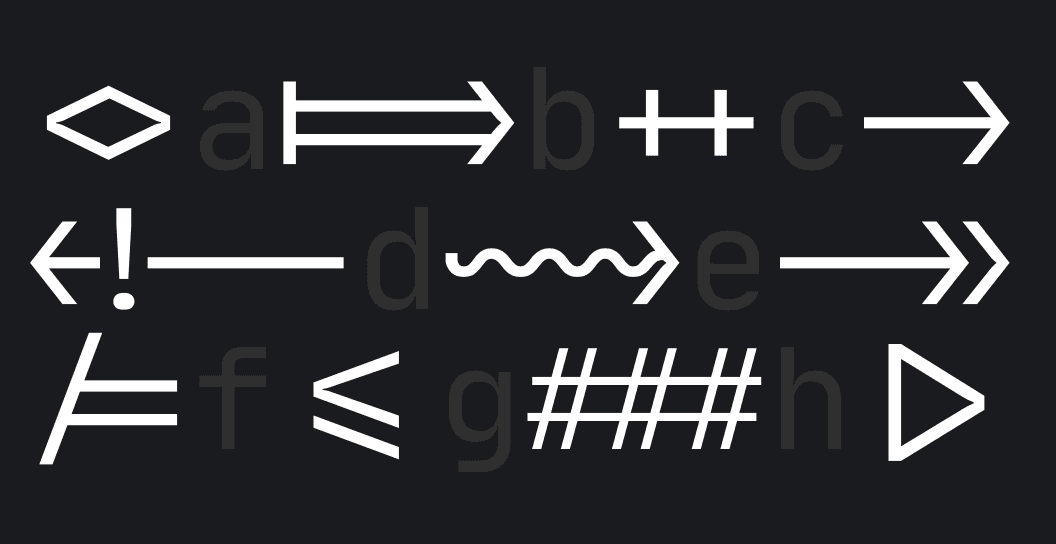
Reduced default text and component size
Along with these typeface changes, we also updated the default font size, and reduced the size of all components across the app. This gives you more screen real-estate to view and compare data while working in Basedash. You can control the zoom level of Basedash at any time by pressing ⌘ + to zoom in, or ⌘ - to zoom out.
Other improvements and fixes
Improved performance of loading tables by 45%
Added
go to Tablecommand in command barUpdated symbols for keyboard shortcuts to use custom icons
Fixed links to tables in Activity page
Updated styling of command bar
Removed unnecessary data fetching in views
Improved performance of updating records
Fixed window closing after applying a filter
Fixed floating buttons being transparent on hover
Fixed records not reloading after updating a view
Dec 7, 2021
Inline filter descriptions
We now show a description of your root filters inline in the view builder sidebar itself, so you know exactly which records are being included. You can click on the filter in the sidebar to edit the root filter on the view.
Change member roles
Admins can now change a member's role from the members page. This makes it easy to update permissions on the fly.
Other improvements and fixes
Updated redirection after connecting a data source to navigate to the data page
Improved performance of loading primary keys of tables
Fixed SQL view data not appearing on mobile
Fixed "Jump to" button appearing on mobile
Fixed temporary filters persisting after switching between tables
Nov 30, 2021
Edit text columns as dropdowns
You can now configure certain text columns in your database to be editable as a dropdown with a restricted set of values. This is very useful in cases where you don't want to use an enum, but have a limited set of allowed values. This improves the editing experiences, and prevents cases of typos and mistakes that could cause errors due to incorrect values.
You can enable this on a per-attribute basis in your data source settings. Just enable "Restrict values", then enter the allowed values, one per line.
Improved view and table search
We've updated the search functionality in the root Views and Data pages to let you quickly navigate to a specific page you're looking for. Now, when you open either the Views or Data page, you'll simply see a search bar, with a super performant and keyboard-navigable list of matching views or tables.
Hit '/' to select the search bar, use the arrow keys to navigate the list, then hit return to open the selected view or table.
Other improvements and fixes
Added ability for admins to change a member's role
Added workspace icons to all items in the workspace switcher
Added persistence to raw table column widths across workspaces
Added persistence to data source sidebar collapsed state for sections
Added loading indicator to data sidebar after connecting a new data source
Added primary attribute to "Visible in list" section in view builder
Improved the configuration of the global navbar
Eliminated unnecessary data reload when resizing columns in a view
Updated the "Jump to" bar to trigger the root command bar
Fixed CSV downloads showing numbers instead of column names
Fixed foreign keys of joined tables not showing values
Fixed newly joined table attributes not immediately appearing in view builder
Fixed inputs overlapping in filter popover
Fixed banner in demo workspace creating unnecessary scrollbars
Fixed null foreign keys showing as an empty chip
Nov 23, 2021
Workspace switcher and desktop navigation
Expanding on our new global navbar from last week, we've added a workspace switcher, and back/forward navigation buttons (on desktop). This now makes the top navbar your hub for all top-level navigation around the app, with the sidebar acting as a way to jump between specific content.
We have more desktop-specific improvements planned for future releases. If you haven't already, you can download the Basedash desktop app for all platforms here: https://www.basedash.com/download
Other improvements and fixes
Added custom scrollbars
Added special text to indicate empty string cells
Removed view data refresh when resizing columns
Improved loading performance for self-hosted instances
Improved layout on mobile to prevent content being overlayed
Updated ordering of data sources in sidebar to prioritize connected, healthy data sources
Fixed joined table attributes not appearing in view builder until refreshing
Fixed primary attributes of joined tables not loading
Fixed disconnecting attributes
Fixed data sources not being removed from the sidebar after removing a data source
Fixed foreign keys not loading in SQL Server databases
Fixed updating data source name and connection status
Fixed enum cell padding being too big
Nov 15, 2021
New top-level navigation
We've spent the past few weeks redesigning the top-level navigation of Basedash. We're excited to finally ship this new experience to all users. We had two primary goals for the redesign:
Simplify the mental model of views & data sources
Surface views in the sidebar directly to speed up navigation
To solve these, we now have a new global navbar with three primary tabs: Home, Views, and Data. The navigation sidebar is dynamic depending on the tab you're on, allowing you to quickly navigate between relevant content through the sidebar directly.
The Home tab holds all of your workspace-level information like Activity, Members, and Settings. We plan to expand on this tab in the future with workspace insights and quick navigation.
The Views tab now shows all your published views directly in the navigation sidebar. Favorited views are still pinned to the top for easy access.
The Data tab lets admins access raw tables and configure data sources. Similar to the Views tab, all tables can be access directly from the navigation sidebar (no more double sidebar!). You can also view your database credentials and manage your connection here.
We're excited to see how this changes your workflows. Let us know if navigation feels more intuitive or faster, and if you have any ideas on how to improve it further. You can join our Community Slack group to share your feedback.
Other improvements and fixes
Improved performance of loading tables from SQL views
Improved performance of loading activity in big workspaces
Reduced page size from 50 to 25 to improve table loading performance
Changed icon representing database tables
Changed "Base table" in view settings from a disabled input to a chip
Added primary key values to foreign key popover in addition to primary attribute values
Updated our live chat widget
Updated references to Sync Inc to Sequin
Updated Sequin data sources to be read-only
Updated list layout views to show 3 list attributes by default
Fixed disconnected tables showing in view creation page
Fixed data source configuration page not rendering in some cases
Fixed activity not showing the relevant data source of edits
Fixed positioning of empty state text on empty pages
Nov 1, 2021
Self-hosting
We're now offering the option to self-host Basedash on your own server for users with strict security needs. We provide a public Docker image which you can run on any VM, including in your existing VPC with limited external networking for maximum security. Self-hosting is available on the Enterprise plan, which also offers unlimited data sources, members, views, edit history, real-time Slack alerts, and dedicated support.
We're currently manually onboarding users for self-hosting to ensure that everything goes smoothly. If you're interested in self-hosting Basedash, send us an email at hello@basedash.com and we'll get you set up.
Other improvements and fixes
Added company logo for new workspaces which appears in the sidebar
Unified keyboard shortcut design across the app
Improved performance of command bar
Fixed updating primary attributes from the data source configuration panel
Oct 26, 2021
Stripe, Shopify, Twilio, and Close integrations
We've added support for four new integrations, so you can now connect your data from Stripe, Shopify, Twilio, and Close right into Basedash, alongside your SQL database (or Airtable base). These integrations are read-only for now, meaning you can view data from these sources, but not make edits from Basedash. You can also use SQL views to query data from these sources.
We're able to support these integrations thanks to our friends at Sync Inc. Sync Inc supports syncing your external data sources to a PostgreSQL database, either hosted by them, or to your existing database. If you choose to sync to your existing database, you can even use SQL queries to join data across data sources. This lets you build cool things like unified user dashboards that combine data from your SQL database, CRM, and Stripe.
Other improvements and fixes
Improved view builder interface
Updated filters to use attribute display names in view builder
Oct 18, 2021
Improved keyboard navigation & accessibility
Accessibility and keyboard navigation are incredibly important to us for two reasons:
Our vision at Basedash is to enable everyone within a company to easily access the data they need to
Basedash is built for power-users, and we want to reduce the time it takes to take action on your data
We've been consistently updating the UI components within our app to be as accessible as possible. The latest change we've made is to our dropdown menu component, which now uses the latest accessibility standards, and adds full keyboard navigation.
We'll continue updating our components and plan to eventually open-source our component library for others to use.
Other improvements and fixes
Improved performance of loading views in table layout
Improved filter reliability when changing the attribute
Added header and footer to views when loading data
Added header and footer to views when an error occurs
Added detection of columns being removed from a table
Added ability to automatically unset a table's primary attribute if it's been removed from a table
Fixed foreign key values not appearing in some cases
Fixed Slack notifications showing attribute names as "undefined"
Fixed fetching tables if missing read permission for a subset of the database
Fixed removing data sources
Fixed foreign key tooltip showing the primary attribute instead of the raw value
Fixed loading values for columns with very long names
Oct 4, 2021
Attribute descriptions
Column names in databases can be confusing. They're named by engineers for use in code, not for people. We already humanize the names in the UI (and let you override the display name to something completely different), but now we're adding another level of customization: descriptions.
You can set attribute descriptions in the data source configuration menu. After that, we'll show you the description whenever you (or your teammates) hover over the column header in a table or view. We have plans to incorporate these descriptions into the list layout too, for users who prefer that layout type.
Automatically-set primary attributes
"Primary attributes" is a concept we introduced a few months ago. It lets you pick a column for each table to act as the identifier, which is shown across Basedash. We show the primary attribute as the value for foreign keys, as the title in list layout, and as the sticky column in table layout.
We used to always default the primary key of the table, but we now scan the column names for some good candidates, including "name" or "email" to use as the default. If we can't find anything good, we'll use the primary key as the fallback. You can always override the default primary attribute in your data source configuration.
This should make list layout a lot more usable by default without having to configure your data sources. Give it a try!
Other improvements and fixes
Added read-only "Name" fields in data source configuration panels
Added read-only "Base table" field to view builder
Added view deletion confirmation dialogs
Re-implemented query autocomplete with better performance
Updated the default primary attribute to look for certain column names, instead of the primary key
Updated "favorite" icon in the disabled state
Updated "Edit view" button icon and text
Updated label in connect data source flow for "Display name"
Updated table headers to show the display name
Fixed deleted records not disappearing in the UI right away
Fixed edits not working in views where the primary key column is hidden
Fixed duplicate tables in the table selection sidebar
Fixed icon color in dropdowns on hover
Fixed icon color in sidebar when selected
Fixed local cache being cleared when switching workspaces
Sep 27, 2021
Improved performance loading list of tables
We've been working hard behind the scenes for the past month on large foundational improvements to Basedash's architecture. These improvements will allow us to build new features faster, onboard new teammates more efficiently, and significantly improve performance across the app.
This week, we made our first performance improvements based on these structural changes, started with the loading performance of tables. We use a hierarchical cache system to load the tables in your database nearly instantaneously, allowing you to navigate your database as fast possible. These changes apply to all instances where we render a list of tables from your database, including the sidebar, view creation, and data source configuration.
These performance improvements have proven to be a success, so we will continue to implement these changes to more areas of the app over the coming weeks.
Foundation for improved stability
We've also spent a significant amount of resources on improving stability of the app, through increased test coverage, and better QA processes. We're committed to building a tool that your team will be comfortable relying on for mission-critical workflows.
These improved processes helped us detect and fix a record number of bugs—see below for details.
Other improvements and fixes
Added "Edit view" button directly to view header
Added "is null" filter option to number attributes
Removed "Joined tables" section in view builder for tables with no foreign keys
Improved first-load performance
Improved accessibility and keyboard navigability of switches
Improved styling of data source configuration panel whitespace
Updated data source configuration panel header text
Fixed behavior causing users to get logged out when API calls failed
Fixed updating data source names
Fixed SQL view queries being reverted when exiting edit mode
Fixed data source names not loading in the sidebar
Fixed updating data source credentials
Fixed updating data source configurations
Fixed raw tables not rendering correctly for databases with multiple schemas
Fixed fetching data source configuration settings for workspaces with databases that are not accessible
Fixed text color of button on hover in Slack alert notification modal
Fixed undoing edits not updating the table UI immediately
Fixed foreign key dropdown values showing as empty in some cases
Fixed disconnecting attributes
Fixed updates to views not appearing immediately in the UI
Fixed old tables and attributes appearing in data source configuration panels
Fixed data source health indicator
Sep 13, 2021
Duplicate SQL views
This week we added the ability to duplicate SQL views in two clicks. From any SQL view, just click the dropdown menu in the header, then click "Duplicate view". This lets you easily create modifications of existing views without affecting the original.
Other improvements and fixes
Fixed persistent loading spinner for data sources in sidebar
Fixed setting date AM/PM values in MySQL
Updated favicon to use the new logo
Updated theme switcher to use the new logo
Fixed workspace creation not redirecting after submission
Fixed removing data sources
Fixed disconnecting attributes in data source configuration
Aug 30, 2021
Improved stability of loading views
If you're an active Basedash user, you may have experienced the dreaded "Oops, something went wrong" error. It happens when we run into an error somewhere along the way of loading data for a view (or raw table). This is usually caused by a logic error in our code that converts your view into a SQL query that we run on your database.
This bug can be incredibly annoying, so we spent this past week focused on solving it. The solution took form in a few different ways:
We fixed one cause of this issue, where loading a raw table could fail if it contained too many columns. This was caused because we used to pass all of the attributes in the API header, leading to an overflow of data. We switched to using POST calls and passing this data in the body of the API call, which fixed the issue.
We fixed another cause of this issue, where hiding a primary key column on a view would cause it to fail. This was caused by an issue with column aliasing which we were able to get around with some clever SQL querying.
We improved the error message when this issue occurs, with a button to message the team with context around the issue. This helps us debug and prioritize occurrences of the issue.
Finally, we now track occurrences of this issue as a KPI to determine when a new root cause pops up, allowing us to fix it as soon as the issue goes live.
This is the first step to improving stability of the app. We plan to vastly expand our testing suite which will prevent new bugs from entering the app wherever possible.
Other improvements and fixes
Improved intro animation of "Run query" button
Fixed app crash caused by database columns being deleted outside of Basedash
Updated Ngrok connection to automatically strip out host protocol
Replaced data preview overlay with a banner when creating a new view
Removed header in the preview window of the view builder
Fixed name showing as always being taken when connecting a data source
Added a link to chat with the team when encountering a view loading error
Updated display names of tables and attributes to be humanized by default
Fixed issue with the filter popover appearing below the form panel in list layout
Aug 23, 2021
Auto-login to roadmap
Last week we launched our public roadmap, with the ability to request and vote for new features. This week we're expanding on our public roadmap by automatically logging you in with your Basedash account when you navigate from the app.
There's a new link to access the roadmap from the app—you can access it by clicking on your name at the top of the sidebar, then clicking Request a feature.
Other improvements and fixes
Removed Related section from sidebar
Fixed ability to join tables in views
Added error message when deleting a record fails, with link to related record when applicable
Fixed editing records not on the first page of results
Fixed tables with multiple foreign keys to the same table showing the same value
Hid auto-generated Supabase schemas
Updated login and signup pages to be draggable on desktop
Updated blog header to match rest of marketing site
Updated name of auto-generated demo view after creating a workspace
Removed requirement for password when connecting a database
Added loading spinner on foreign key popover
Aug 16, 2021
Public roadmap
Today we're launching our public roadmap, where we'll be accepting feature requests and tracking their progress as we build. This gives us an easy way to track what features are most highly requested.
You can access the roadmap and request a feature at https://roadmap.basedash.com.
Other improvements and fixes
Added an error message when connecting a data source fails in unexpected ways
Fixed Slack notifications
Updated styling of data source connection form
Added a demo database and view to all new workspaces
Fixed data source configuration loading incorrectly
Fixed data source configuration header spacing on desktop
Fixed data source configuration headers not always being the same height
Fixed uneditable table cells visually showing as editable in some cases
Fixed entire tables showing as uneditable in some cases
Fixed "Unable to load view" toast appearing multiple times
Fixed "display as checkbox"
Fixed upgrading and downgrading workspaces
Fixed views being removed when editing certain data source configurations
Improved realtime performance
Fixed linking to raw tables from the command bar
Updated onboarding email sequence
Updated styling of view titles
Fixed CSV downloads only loading the first page of data on SQL views
Fixed filter popover z-index issue
Fixed attribute popover overflowing page
Fixed attribute popover button spacing
Added padding to bottom of data source configuration panels
Updated data source configuration headers to be sticky
Fixed foreign key popover input styling
Fixed sidebar items being ellipsed too aggressively
Updated segmented controller styling to match inputs
Fixed data source connection to allow for very long credentials
Fixed search query and page number carrying over between views
Updated styling of inputs in view settings to match other inputs
Fixed views loading multiple times after being created
Fixed sort popover attribute items all being the same
Fixed views with large number of attributes not loading
Fixed SQL views in chart layout being paginated
Fixed editing datetimes by text
Added custom default value for "SSL enabled" when connecting a data source depending on hosting provider
Fixed collapsible arrow being visible in sidebar items when expanded
Fixed new views not showing up immediately in views page
Updated icon for chart layout
Added automatic query saving
Updated styling of "Run query" button
Aug 2, 2021
Data source configuration
Privacy and security are absolutely essential when dealing with user data. We spend a lot of time building features and processes around this—things like activity history, roles + permissions, and configurable views. Today, we're introducing a big new feature: data source configuration.
This new feature lets you configure how your data can be accessed from Basedash in a few key ways:
You can fully disconnect certain attributes or tables that you don't want anyone on your team to access.
You can also toggle what's editable, in case you have certain attributes that contain sensitive PII, or are linked to external business logic.
Finally, you can also customize the display name of data sources, tables, and attributes. We provide sane defaults that make your data more accessible to non-technical users, but you always have the final say. Note that this does not change your underlying database in any way, just the way it gets displayed in Basedash.
These new fine-grained settings give you full control over what you and your teammates can access through Basedash, improving privacy and security. We have plans to add even more customization in the future—follow us on Twitter to keep up to date with the latest updates to Basedash.
Other improvements and fixes
Improved loading performance of views and raw tables
Improved styling of collapsible sidebar sections
Updated Optional text on form fields
Updated icons used on data sources
Updated cursor used on date cells
Updated styling of input fields across the app
Updated styling of search bar to match other inputs
Updated search bar text in sidebar to "Jump to"
Updated chart colors
Fixed certain dropdowns being resizable
Fixed views with many attributes not loading
Fixed background color on JSON fields not matching theme
Fixed form panel title overflowing
Fixed loading spinner behaving erratically
Fixed data not updating when switching between SQL views
Fixed pagination icons not being consistent
Fixed tooltip text in view settings
Fixed vertical alignment of chips in activity page
Jul 26, 2021
Custom context menus
We've added custom right-click context menus to the app which let you quickly take actions on certain items. To start, they're available on the Views page (to edit, favorite, and delete), and in the headers of tables (to set the primary attribute, and apply a sort). This also freed up left-click on table headers, which we're now using to quickly apply a sort on a column.
We plan to use context menus more heavily across the app as we keep building, to simplify the UI and make taking actions faster.
Search in SQL views
We've added text searching to SQL views to allow you to easily filter for records containing some text. We've had this functionality in Basic views for a while, but wanted to bring it over to SQL view too. This is the first step in bringing full feature-parity across both Basic and SQL views. We plan to add UI-based filtering and sorting to SQL views as well.
You can trigger a search on a SQL view by pressing Ctrl/Command+F. Note that we previously used Ctrl/Command+F for find and replace on the query—this has now switched to Ctrl/Command+Shift+F.
Other improvements and fixes
Added a link to invite a member while connecting a data source
Added live chat to app
Added a link to join a demo workspace after signing up
Added a banner to the demo workspace
Changed SQL view pagination to only load one page worth of data at a time
Fixed creating new records in some cases
Fixed removing data sources
Fixed connecting to databases through SSH
Fixed workspace switcher not updating immediately after creating a new workspace
Improved ability to copy substrings of text from uneditable cells
Improved error messages encountered while connecting a data source
Merged profile page into settings
Jul 19, 2021
Darker dark mode
What's better than dark mode? An even darker dark mode!
We've updated our color scheme across the app to use darker darks, and a higher-contrast primary color on both themes. Overall, we've simplified our color palette which should increase consistency across the app.
We have lots of ideas on how to expand our theme system in the future to improve customizability, accessibility, and fun. Keep your eyes out for future changelogs by following us on Twitter (@Basedash).
Other improvements and fixes
Merged the Profile page into Settings
Updated labels on the signup form
Updated styling of sidebar section titles
Updated sidebar sections to persist collapsed state across sessions
Added a "Done editing" button to view settings
Added sort buttons in the column dropdown on tables
Added an empty state to the views page
Added space for traffic light buttons on view settings on desktop
Replaced checkboxes with switches in the Available attributes popover in view settings
Updated styling of switches to use the primary color when active
Improved the back button behaviour on the connect data source page
Improved consistency of buttons across the app
Reduced default height of buttons
Fixed header not being visible on the activity page when no databases are connected
Fixed some disabled buttons being clickable
Fixed view settings being too tall when using some layouts
Fixed null booleans not being editable
Fixed sidebar button appearing on both headers in view settings on mobile
Jul 12, 2021
New view creation flow
This week we revamped the way you create, edit, and share views. We now have a full-page experience that allows you to configure and preview your view in real-time, across multiple layouts (table, list, and chart). This brings all view configuration options to one place, allowing you to craft your perfect view.
Newly created views are saved to Drafts which are only visible to admins. You can publish your view to the rest of your team in one click. This makes is easy to work on a view on your own time, then publish it when you're ready to share with your teammates.
Collaborators can still navigate views by searching and sorting, but only admins can edit the view to change core settings like filters and joins. Admins can access view settings by clicking the "..." menu in the header of a view, then clicking "Edit view".
We think this new format for creating and managing views simplifies the process for admins, and allows us to add more customization in the future without cluttering the view interface. We'd love to hear your thoughts and feedback in the BaseDash Slack community.
New view layout switcher
We also updated the layout switcher on views to use a newly designed segmented controller. This better-exposes your layout options for working with your data, and lets you switch your layout in one click.
Other improvements and fixes
Improved accessibility of the switch component
Fixed date column values being cut off in table layout
Fixed search term not being visible after applying a search
Fixed future date values showing as "Out of range"
Fixed foreign key popovers appearing behind sticky columns
Improved foreign key popover styling
Fixed undoing values not showing changes immediately on the form panel
Fixed toggling the enabled status of Slack notifications on views
Changed null values to display as a dash
Updated all list attributes to be left-aligned
Updated the data type icon for foreign keys
Jun 28, 2021
Date picker
This week we shipped a date picker that makes it easy to update date values by picking a date on a calendar. You can also type a value directly into the input field in a simple, human-readable format. It works for both simple dates, and date-time combos, in both table layout and list layout.
Other improvements and fixes
Updated our blog to be available at www.basedash.com/blog
Fixed a bug causing table cell values to not visually update
Fixed a bug causing list values to visually revert after leaving and returning to a record
Jun 21, 2021
List layout
Today we're launching a new list layout for views, our second ever layout type after tables. You can now easily view records in a simple list, and edit values in a comprehensive form. This new view layout is available on all new and existing views through a toggle in the header—you can use this to easily switch the layout on a view-by-view basis depending on your needs for each view.
We believe that tables are great high-density interfaces for comparing and managing data in bulk, but they can be intimidating—especially for non-technical users—because they lack informational hierarchy. Our new list layout offers a more streamlined interface, surfacing the most important data in the list itself, with access to the rest of the record's data in a familiar, easily-editable form. The form panel also gives us more space to show data inline which is especially useful for data types like rich text and JSON.
List views, like existing table views, are highly customizable. You can choose which secondary attributes to display in the list, as well as which attributes are visible and editable in the form. Some settings like filters and sorts are shared between layout types, so you don't have to define them multiple times.
List layout is available to all users starting today. It's still under active development while we iron out some bugs and improve the experience, like adding mobile support and improving customizability. If you run into any issues, please let us know in the BaseDash Community Slack channel.
Other improvements and fixes
Updated "New update available" toast copy
Fixed bug that prevented deletion of favorited queries
Fixed bug that prevented foreign key selection dropdown from appearing
Jun 14, 2021
New avatars
We updated the way auto-generated user avatars look, and how they're rendered when used as real-time presence indicators on a view. Upon signup, each user is now assigned a color from a collection of hand-picked colors. This will appear as the accent color in your avatar, as the border in the top-bar, and as the border of your currently-selected cell to other users. Your color is persistent, allowing your teammates to easily recognize you by your color.
New blog
We also launched an updated site for our new blog! We'll be posting content about how we're designing, building, and growing the product. It's exclusively high-quality content written by the core team at BaseDash. We already have a couple posts up:
You can check out the full blog at https://blog.basedash.com.
Other improvements and fixes
Re-ordered table controls in preparation for an upcoming change 👀
Jun 7, 2021
Related views section
We've been doing a lot of experimentation around navigation in the app. The latest change we're trying out is a "Related" section in the sidebar that intelligently shows views that are related to the page you're currently on. If you're on a view or raw table, this includes any views with the same base table. If you're on a query, it includes other queries based on the same data source. This should speed up navigation in the app, especially when exploring data.
We'd love to hear your thoughts as we build in public. Join our Slack community to chat with other power-users, as well as our designers and engineers—we're constantly updating BaseDash based on user feedback.
Other improvements and fixes
Updated positioning of sidebar items
Changed primary attribute column to not be sticky on smaller screen sizes
Fixed CSV downloads containing column names and values with certain characters
Fixed primary attribute becoming transparent when highlighted via search
Fixed column default values being detected incorrectly
May 31, 2021
Updated permission system
We reworked our permission system from the ground up to simplify the process of adding teammates, and to increase flexibility out of the box.
Our old permission system relied on defining read/write permissions upfront at the table level. This allowed for fine-grained permissioning, but required a huge time commitment to set up, and was hard to keep up-to-date as needs (and schemas) changes.
Our new system works off the existing power of views. We now have 3 roles:
Admin. Has full access to data sources (including raw tables), and can create + publish views for others to use.
Collaborator. Only has access to existing views which were created by admins.
Read-only. Can only read data in existing views, but not make edits.
These new roles are specifically tuned towards the ability to craft views with limited access through filters and hidden attributes, ensuring that your teammates have access to the data they need, and nothing more. Collaborators still have the ability to search within views, and we're planning ways for them to organize data in new ways.
On top of these three roles, we also have the concept of Owners. Each workspace has at least one owner who, on top of their role permissions, gains access to billing and top-level settings like renaming the workspace. Right now, the creator of the workspace is designated owner, but we plan to let you transfer ownership and add new owners in the future.
Finally, the new Read-only role is free, so you can add as many teammates/investors/users as you'd like without affecting your billing.
Other improvements and fixes
Added the ability to filter on JSON columns
Fixed query results missing the final record on each page
Fixed number of collaborators being miscalculated by one
May 24, 2021
Improved mobile experience
One of our core goals at BaseDash is to democratize data access within companies so that anyone can work with the data they need to, in the way that works best for them. We've noticed an increase in the number of people using BaseDash on mobile, so we decided to make some improvements to the experience on smaller screens.
We've always had basic support for mobile, but it's slowly gotten out-of-date with all the new changes we've introduced in the past months. This week, we implemented some changes that bring the experience closer to that on desktop, with design improvements that make it easier to keep feature parity as the product changes over time. We now have a persistent header across all pages—including on desktop—which includes a menu button to open the sidebar on smaller screen sizes. We also hide some information on smaller screens to maintain high information density.
Other improvements and fixes
Updated sidebar item styling
Updated sidebar search bar styling
Improved view footer responsiveness
Increased view search bar width
Fixed updating Slack integration settings
Fixed view deletion
Fixed enabling two-factor authentication
Fixed real-time avatars not showing in views
Fixed filter value field not appearing
Fixed reordering columns
Fixed loading the payment page when it's the initial page loaded
Fixed cell highlighting when searching
Fixed applying filter changes on text columns
Fixed app update toast not appearing
Fixed switching view visibility not updating the views page
May 17, 2021
Sticky columns
We've added the ability to designate a "primary attribute" on each table, which freezes the column to the left side of the table. The primary attribute defaults to the primary key of the table (i.e. the ID), but you can set it to any attribute by clicking the column header and selecting "Set as primary attribute".
In addition, the primary attribute will appear as the value in foreign key relationships. This means that you can easily read and set relationship values without having to know the record's ID. It's very useful for setting a user's primary attribute as their email or name.
Search in queries
We also added new search feature in queries that allows you to easily scan your SQL queries. It supports find-and-replace, regex, case-sensitivity, whole-word search, and search-in-selection. You can trigger it by pressing Ctrl/Command + F in a query.
Other improvements and fixes
Simplified onboarding flow
Fixed onboarding flow triggering twice in some cases
Fixed global search not showing tables if a database connection failed
Fixed sidebar flashing when navigating between pages
Fixed record deletion in MySQL
Fixed removing members from Basic workspaces
Added a link on the Views page to connect a data source in new workspaces
Updated table footer formatting
Fixed keyboard shortcut conflicts on Views page
Fixed columns widths not going below content size
Fixed table header not spanning page width
Fixed query values being cleared after setting an emoji
Adjusted filter dropdown alignment to prevent overflow
May 10, 2021
Performance improvements
We spend a lot of time thinking about how to improve the performance of BaseDash. Unlike most software, we not only have to connect to our own servers, but also to your database, which adds another step into each network request. This means that we're fundamentally challenged on performance. Despite this, with good software engineering, we believe that we can build BaseDash to feel faster than 99% of software.
We spent the past week overhauling all of the code that manages fetching data. This allowed us to eliminate unnecessary network requests, add smarter client-side data caching, and improve data-loading dependencies. Here are the results:
Up to 25% faster page load times
Up to 80% less data transferred
Up to 70% fewer API calls
We're really happy with these results, but we think there's always room to improve performance, so it'll continue to be a priority moving forward. If there's any part of the app that you feel is slow, let us know on our Slack community and we'll prioritize it.
Other improvements and fixes
Added a status page
Added a connection error indicator on databases in the sidebar
Improved search bar focus state
Improved record creation by automatically reloading data on creation
Fixed filters not being applied when loading a view
Fixed databases persisting in the sidebar after deletion
Fixed column widths in newly created views
Fixed "does not contain" filter
Removed expanded record modal
Removed column creation
May 3, 2021
Views page keyboard navigation
We've improved the keyboard navigation on the views page to make it easier than ever to get to your data. You can now use the arrow keys or 'j' and 'k' to navigate through the list, 'return' to open the selected view, and 'f' to favorite a view, pinning it to the sidebar. You can also now press 'g' then 'v' to go to the views page. As before, you can press '/' to open search and jump straight to a view from anywhere.
We're big fans of keyboard navigation and aim to make the entire app keyboard navigable. We're currently about 90% of the way there.
Other improvements and fixes
Updated the styling of the views page
Fixed alignment of real-time avatars in the view header
Updated the "Save as view" button in tables to always be visible
Added favorite button to the view and query headers
Added an empty state for the favorites section in the sidebar
Switched the sort order for views using emojis
Updated header padding on desktop
Apr 23, 2021
New views page
Views are the base unit in BaseDash—they're how you organize data and share insights across your team. Until now, we've shown all your views directly in the sidebar. This works well when you just have a handful of views, but quickly gets out of control as your team generates many views.
To solve this, we created a dedicated page to see all your views in one place. Beyond just the name, we also show the database and table that the view pulls data from, and when it was created. From here, you can individually choose to favorite certain views that you use regularly to pin them to your sidebar for easy access. Favorites are unique to each user so they won't affect your teammates.
We also now sort views by their emoji first, then alphanumerically, which opens up another layer of organization to your views page.
We have big plans around how to let you organize views even more in the future—keep up to date by following us on Twitter.
Other improvements and fixes
Updated the action bar across tables, views, and queries
Added a dedicated page to view and add members to your workspace
Fixed enabling two-factor authentication
Fixed uneven line height of some links
Updated spacing of cards
Added record, table, and database chips on activity
Changed the cursor to arrow when hovering over most text
Added tooltips on table identifier chips to show the underlying value
Fixed native browser behaviour for Cmd + L shortcut
Fixed native browser behaviour for Cmd + Option + Left/Right shortcuts
Fixed getting logged out when connection to the server is temporarily lost
Apr 16, 2021
Database connection instructions
Connecting to a database can be difficult, involving trusted sources, credentials, certificates, and more, depending on your setup. We've added inline instructions and videos on how to find some of this information while connecting a data source in BaseDash.
Specifically, we now show text and video instructions on:
Finding your database credentials
Adding BaseDash as a trusted source to your hosting provider
Connecting to a locally hosted database
We currently have videos for all major managed database hosting providers with plans to add more in the future.
Other improvements and fixes
Updated the icons for boolean and enum columns
Added a Security page
Fixed filters containing certain characters in their value
Fixed showing boolean values from queries
Added proper formatting for time columns
Fixed empty rows showing at the top of views in some cases
Apr 9, 2021
Slack community
BaseDash now has a public Slack community! We'll be using this to share tips and updates to the tool, and showing off some sneak peeks of product changes before they go live. It's a great place to chat with the team and other power users about the future of BaseDash, and how to use the tool to its full potential.
We try to be incredibly responsive to bug reports and feature requests. Let us know what's been bugging you in the #bugs channel, and what you'd like to see us add in #feature-requests.
Join the Slack community here—we're looking forward to meeting you!
Other improvements and fixes
Added custom tooltips across the app
Added an account dropdown to the sidebar to quickly access the changelog, Slack community, and support email
Fixed URL being persisted after logging in
Fixed crash after logging out and back in as a new user
Added hosting-provider-specific instructions on how to add BaseDash as a trusted source
Changed titles from uppercase to sentence case
Added a confirmation toast after connecting a data source
Updated the button icons on URL and foreign key cells
Added persistence to the email field when switching from the login to signup form
Fixed showing an infinite spinner instead of an error message when loading a view fails
Fixed real-time user avatars all showing your own avatar
Fixed cells randomly getting cleared while creating a new record
Fixed undoing boolean edits not showing the new value in the table
Apr 2, 2021
Redesigned add database flow
Adding a database is the first step of using BaseDash, yet it's one of the most difficult. We decided to totally redesigned the flow to make it simpler and to give more useful information while moving through the process.
We now ask you where your database is hosted so that we can automatically fill default values wherever possible, update form labels to match how they're presented by hosting providers, and link directly to your hosting provider's dashboard. We also plan to add inline videos showing how to find credentials for each hosting provider.
Other improvements and fixes
Updated toast animations
Fixed the cursor on checkboxes on the Activity page
Fixed queries layout on mobile
Fixed showing edits to or from a null value on the Activity page
Fixed setting date values using SQL functions like "now()"
Apr 1, 2021
Stories
Expanding on last week's redesigned activity page, this week we decided to implement our most requested feature: stories. Stories let you quickly share snapshots of your views and queries from across your workspace. They're great for sharing wins like notable user signups and usage milestones. Stories disappear after 24 hours since they're meant to show relevant data in real time.
Of course, stories are fully keyboard-navigable—just press C then S to instantly create a story based off the page you're currently on. You can view active stories in your workspace on the Activity page along with your edit history.
We're excited to hear your feedback and see how you use stories to share insights across your team!
Other improvements and fixes
Migrated the codebase to WASM to improve performance
Added support for Figma as a data source
Removed Herobrine
Mar 26, 2021
Redesigned activity page
Being able to see activity within your workspace is incredibly valuable for teams using BaseDash. It lets you get a pulse for how your teammates are using the tool, and makes it easy to catch mistakes before they have an impact on your product.
We fully redesigned the activity page to show more context around edits, with things like checkboxes for booleans, nicely formatted dates, and properly indented JSON. This makes it much easier to quickly compare the before and after values of edits.
We have even more changes planned for the activity page that aren't quite ready to ship yet. Keep your eye out for future changelogs by following us on Twitter.
Other improvements and fixes
Improved the interface for queries, with the ability to toggle a fullscreen SQL editor
Improved the positioning of the callout on the add database page when connecting using SSH
Updated copy around data sources
Fixed the ability to add databases through SSH
Fixed the ability to copy a substring of text in a non-editable cell
Mar 19, 2021
New pricing model
Our vision at BaseDash is to build the new standard for internal tools which enables everyone within a company to easily access the data they need to. Achieving this vision requires everybody from large companies, to early startups, to individuals working on side projects, to be able to use BaseDash. Our old pricing model was too prohibitive to certain small companies, so we decided to rethink it from the ground up.
Our new pricing model is designed to scale both functionality and cost in a way that makes sense for teams of all sizes. Our goal was to only include limitations for features that actually matter depending on your team size (e.g. unlimited edit history for startups, on-prem deployment for enterprise). Beyond that, we don't place any limits on the way you use the tool.
We also offer significant discounts/free access to non-profits and free open-source software projects on a case-by-case basis. Email us for more details.
We hope these changes allow more teams to use BaseDash to improve their internal tools.
Other improvements and fixes
Added support for custom SSL certificates when connecting a database
Added a toast notification whenever there's an update available to the app
Migrated our entire codebase to TypeScript which will increase development speed and reduce bugs going forward
Mar 12, 2021
Contextual toasts
We totally revamped our toast system to show context around each edit you make, with the value before and after each change. If you make multiple edits in quick succession, we'll group them together into a single toast with controls to individually undo edits as needed. We think that showing a quick snapshot of each edit you make will reduce errors and increase speed and confidence in taking actions.
This update also improves error messages by grouping them together into a single toast, saving you valuable screen real-estate.
Other improvements and fixes
Added Vim-style 'hjkl' keyboard shortcuts for table navigation
Migrated all icons across the app to our custom icon set
Added an internally shareable URL to the share menu in tables
Updated default user avatars to show initials
Fixed an issue where private views couldn't be created when at the limit for shared views
Fixed foreign key cells not showing updates immediately if they had a table identifier assigned
Mar 5, 2021
Global view search
This week we added a global search that allows you to jump to any view, query, or table in seconds. It's fully keyboard-navigable and can be opened from the sidebar, or by pressing '/' from anywhere. With this addition, you can now navigate to any page in BaseDash purely with the keyboard.
This is the first of a few updates we have planned to improve navigation and organization of views. We think that views are core to BaseDash, so we want to improve the ways that you can work with them. Keep an eye out for future updates by following us on Twitter.
Keyboard shortcut cheat sheet
Speed is core to BaseDash—we've got loads of keyboard shortcuts for navigation, creation, and manipulation. This week we added a central location to show all available shortcuts in an instant. It automatically detects which shortcuts are triggerable depending on where in the app you are, and lets you search to find specific actions.
You can open the cheat sheet by pressing '?', or by searching for "Keyboard shortcuts" in the command bar.
Other improvements and fixes
Updated styling of foreign key chips
Added an RSS feed for the weekly changelog
Fixed column loading for SQL Server databases
Reduced bundle size and improved performance across the app
Feb 26, 2021
Schema folders
We noticed that some users have large numbers of tables across multiple schemas in their database. Until now, we were organizing these in the sidebar by showing the full schema and table name for each list item in the sidebar (e.g. public / Users). This worked, but the repeated schema names looked ugly and often resulted in table names overflowing past the sidebar.
This week, we added a second level of organization in the sidebar for database schemas. We automatically detect any schemas in your database and create folders for them which can be individually expanded to show the tables within. This should greatly simplify navigation in big databases with multiple schemas.
If you only use a single schema (like public), you won't notice a difference since we flatten the structure to save you a click.
Other improvements and fixes
Added highlight to data type icon in column headers to indicate which column is the table identifier
Fixed views with specific column types crashing
Feb 19, 2021
Query autocomplete
We added autocomplete to our SQL query editor to make it easier than ever to quickly explore data in your database. It automatically suggests table and column names as you type—just hit Enter to fill the selected value. It also automatically quotes any values that use capital letters to ensure that your query runs correctly.
This should significantly speed up the process of writing queries and reduce the amount of debugging required to get your query to pull the data you want.
Other improvements and fixes
Added ⌘/Ctrl + Enter shortcut for submitting changes while editing JSON data
Fixed crash caused by opening a view that contained columns removed outside of BaseDash
Fixed incorrect data showing when switching between tables or views quickly
Feb 12, 2021
Airtable integration
It's super common for early-stage startups to begin development with Airtable as their data store, before eventually migrating to a proper SQL database. Problem is, that migration step is a huge pain, from hosting the database, to generating the schema, to copying over any existing data.
We've partnered with Sync Inc to allow users to instantly migrate from Airtable to a fully-fledged SQL database in seconds. We handle everything from hosting to migrating, while providing the same great data editing experience you're used to. You'll get direct access to your new database's credentials so you can start integrating it into your codebase.
The underlying database runs on PostgreSQL, the industry standard for modern SQL databases—this means that you can write and share standard SQL queries to explore your data in new, complex ways.
Best part is, you don't need to migrate all at once—we'll constantly sync data from Airtable to the SQL database so that you can gradually move your systems over.
We're super excited to see what this new functionality enables. The feature is still early in development so expect lots of improvements in the coming weeks.
Other improvements and fixes
Improved behavior around how applying sorts works
Updated sort icon directions to improve legibility
Fixed enum column editing in certain browsers
Fixed welcome email sequence
Changed behavior of creating new views from a table to save existing filters and sorts
Feb 5, 2021
Slack notifications
We've added a Slack integration so that you can be notified whenever a new record is added to a table. These are linked to views, so you can easily apply a filter to only be notified when a specific kind of record is created. You can send notifications to different Slack channels for each view, and choose to receive notifications in real-time as records are created, or batch them in hourly or daily increments. You can enable notifications in the "..." menu in the top-right of any view.
Other improvements and fixes
Added a button to column headers to instantly sort by that column
Improved sidebar behaviour on mobile
Fixed navigation for return users who haven't yet created a workspace
Removed ability to create views in workspaces with no database
Improved styling of table action bar on small screens
Fixed databases from other workspaces showing in query database selector
Fixed capitalization of certain acronyms in column names
Jan 29, 2021
Foreign key back button
We added a new button to return to the previous table or view after navigating through a foreign key. It's really common to jump to a record associated in a foreign key, grab some information or make a quick edit, then return to the original table. This new back button is the fastest and easiest way to do that.
Other improvements and fixes
Improved database dialect selection interface when adding a new database
Improved drag handle indicator for resizing columns
Improved drag handle indicator for resizing the sidebar
Fixed checkbox being hidden for null boolean cells when focusing the cell
Fixed signups not automatically redirecting to a logged in state in some cases
Jan 22, 2021
Sidebar redesign
We changed the way the sidebar works to simplify navigation and improve organization of views. The new sidebar replaces the nav bar for high-level navigation, so it's now present across the entire app. It also includes some new icons to help you navigate around, including the ability to set custom emojis on your views. You can also now resize the sidebar.
Record search redesign
The search bar in tables and views is now in the action bar, and is faster than ever with updated keyboard shortcuts.
Other improvements and fixes
Improved reliability of search for special characters
Improved the theme picker, adding a Match system option
Locked editing of primary key columns
Improved visibility of uneditable columns with a different background color
Improved contrast on foreign key values
Improved table header styling
Updated action bar to increase window drag target on macOS
Fixed support for setting foreign keys when creating new records
Improved SQL-based views by persisting the View as chart setting across sessions
Improved checkbox styling for boolean columns
Added support for PostgreSQL array columns
Improved default column widths for tables
Updated icon set for column data types
Removed ability to delete columns











































































